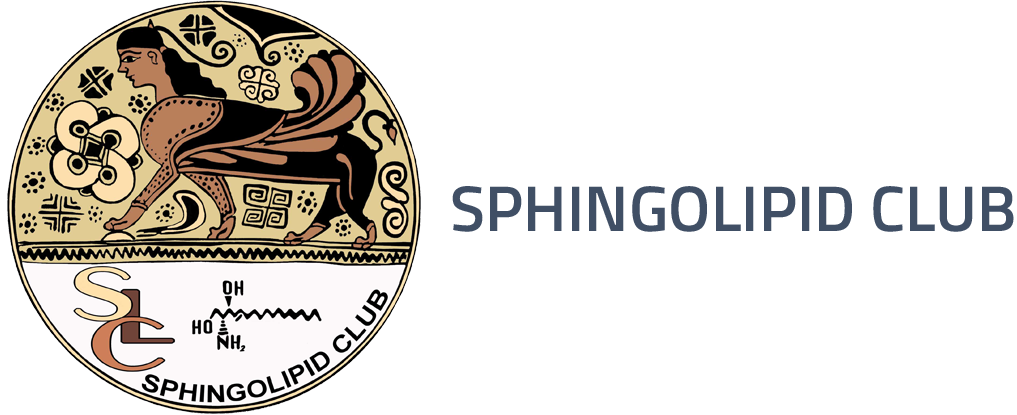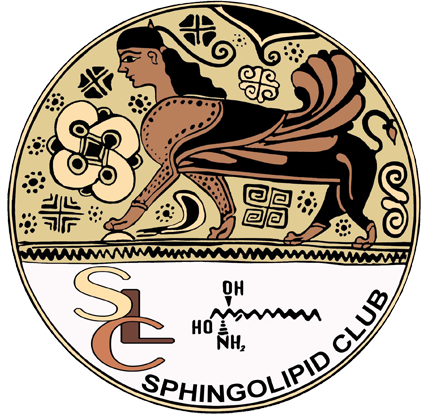12th Meeting
Trabia, Italy, Sept 6-10 2017
KEYNOTE LECTURE
NEW ASPECTS OF SPHINGOSINE-1-PHOSPHATE IN INFLAMMATION AND CANCER
Sarah Spiegel and Sheldon Milstien
Department of Biochemistry and Molecular Biology, Virginia Commonwealth University School of Medicine and the Massey Cancer Center, Richmond, VA, USA.
Sphingosine 1-phosphate (S1P) is a pleiotropic bioactive sphingolipid metabolite that regulates numerous processes important for inflammation and cancer. S1P is generated intracellularly by two sphingosine kinases (SphK1, SphK2) and is exported out of cells by Spinster 2 (Spns2) to exert its effects through activation of five specific cell surface S1PRs in autocrine or paracrine manners. In this lecture, I will focus on several new roles of SphKs and Spns2 in regulation of immune cell trafficking, cancer progression, and pulmonary metastasis. I will highlight critical roles for circulating S1P produced by tumors and the SphKs/S1P/S1PR axis in obesity-promoted inflammation, metastatic niche formation and breast cancer metastasis. I will also summarize the role of Spns2 in autoimmune diseases and metastatic pulmonary colonization. In addition, I will discuss recent studies demonstrating that SphK1 is recruited to sphingosine-enriched endocytic vesicles and that phosphorylation of sphingosine to S1P by SphK1 is involved in endocytic membrane trafficking and autophagy and in the crosstalk between endocytosis and autophagy. Collectively, our work suggests that targeting Spns2 and/or SphKs/S1P/S1PR axis would be a useful therapeutic for several human diseases including metastatic cancers. Supported by the DOD BCRP program award W81XWH-14-1- 0086 and NIH grant 2R01GM043880.
TALKS
INDUCTION OF “ENDOMITOSIS” BY PSYCHOSINE IS CONTROLLED BY MEMBRANE GLYCOSPHINGOLIPIDS AND CLUSTER OF SPHINGOMYELIN
Hiroshi Watanabe, Yuki Itani, Toshihide Kobayashi*, Shogo Oka, Hiromu Takematsu
Kyoto Univ, Japan and * Strasbourg Univ, France
Background
Psychosine (Galactosyl-sphingosine) is a lyso-form of galactosyl-ceramide (GalCer), accumulated in the genetic disorder of galactosylceramidase, Krabbe’s disease. In Krabbe’s disease patient cells, GalCer is the primary lipid species accumulated, its de-N-acylated psychosine is also accumulated and psychosine was suggested as a cause of toxicity. To date, however, it is still elusive how psychosine could cause disease-related biological effect(s).
Results
When psychosine was supplied to proliferating cells, cells underwent special type of mitosis, endomitosis, which sustains cellular content duplication without segregation, resulted in the giant and multiploid cell formation. Endomitosis seemed to be achieved by the defect in the cytokinesis, a final step of mitosis. Here, psychosine’s effect was cell-type specific. Psychosine susceptibility to produce multiploid cells was thus further explored. Membrane glycosphingolipid (GSL) expression positively and sphingomyelin (SM) negatively correlated with multiploid cell formation, indicating the importance of lipid environment in the psychosine-mediated endomitosis. It was reported that SM could form cluster in outer leaflet of the membrane, where juxtapose inner leaflet region could recruit phosphatidylinositol-5-kinase to form PIP2. Psychosine disrupted SM cluster, visualized with lysenin probe, which could be inhibitory for the cleavage furrow maintenance, required for the proper mitosis. Psychosine therefore shifted mitotic cells into endomitotic cells.
Conclusion
These data indicated that membrane lipid environment could be important for the proper mitotic event(s). Moreover, endomitotic cell cycles could be modulated by the lipid composition of the membrane among GSL, SM and phosphoinositides.
IDENTIFICATION OF A FUNCTIONAL SPHINGOLIPID BINDING MOTIF IN LAPTM4B (LYSOSOME ASSOCIATED PROTEIN TRANSMEMBRANE 4B)
Kecheng Zhou1,2, Andrea Dichlberger1,2, Hector Martinez-Seara3, Thomas Nyholm4, Shiqian Li1,2, Young Ah Kim5, Ilpo Vattulainen1, Elina Ikonen1,2, Tomas Blom1,2
1Department of Anatomy, Faculty of Medicine, University of Helsinki, Helsinki, Finland;2 Minerva Foundation Institute for Medical Research, Helsinki, Finland; 3 Institute of Organic Chemistry and Biochemistry, Academy of Sciences of the Czech Republic, Prague, Czech Republic; 4 Biochemistry, Faculty of Science and Engineering, Åbo Akademi University, Turku, Finland; 5 Department of Chemistry and Biochemistry, Queens College, City University of New York, Flushing, NY 11367, USA.
Background
Membrane embedded proteins are functionally regulated by the lipid composition of the surrounding bilayer. Ceramide generated in late endosomal compartments is recognized as a potent regulator of cell signaling, but its molecular interactions with late endosomal transmembrane proteins have not been studied in depth. Here we uncover structural motifs required for ceramide interaction with the four membrane spanning Lysosome Associated Protein Transmembrane 4B (LAPTM4B).
Results
By using a combination of in vitro lipid transfer assays and cell biological methods we find that the third transmembrane domain of LAPTM4B is critical for its interaction with ceramide. Atomistic simulations suggest that a centrally located aspartate residue (D202) in combination with an adjacent sphingolipid binding motif (SLB) are essential for the ceramide interaction. The aspartate residue confers flexibility to the transmembrane helix, while the sphingolipid binding motif are the preferred points of contact for ceramide. LAPTM4B proteins with mutated D202 or SLB display reduced interaction with a crosslinkable ceramide, suggesting that the sphingolipid interaction motif is functional in cells. Ceramide facilitates the heterodimerization of LAPTM4B and its protein interaction partner 4F2hc (Leucine transporter heavy chain) in late endosomes. Mutating either D202 or the sphingolipid binding motif leads to dysregulated heterodimerization of LAPTM4B and 4F2hc and altered downstream mTORC1 signaling. This suggests a role for ceramide binding to LAPTM4B in regulating nutrient sensing.
Conclusions
We identify a ceramide interaction motif in LAPTM4B necessary for promoting its interaction with the leucine transporter heavy chain 4F2hc. The findings give key insight into the mechanisms of ceramide-protein interaction and establishes LAPTM4B as a novel late endosomal sphingolipid sensor.
A NOVEL SPHINGOMYELIN/CHOLESTEROL DOMAIN-SPECIFIC PROBE REVEALS THE DYNAMICS OF THE MEMBRANE DOMAINS DURING VIRUS RELEASE AND IN NIEMANN-PICK TYPE C
Makino A1, Abe M1, Ishitsuka R1, Murate M1, Kishimoto T1, Sakai S1, Hullin-Matsuda F1, Inaba T1, Greimel P1 and Kobayashi T1,2
1RIKEN, Wako Saitama, Japan; 2UMR7213 CNRS, Univ Strasbourg, France
(Background) Plasma membrane lipid domains enriched with sphingolipids and cholesterol (Chol) are known as lipid rafts and have been proposed to play crucial roles in various physiologic events as diverse as signal transduction and viral and bacterial infection. However, the molecular organization and dynamics of sphingolipid/Chol domains are not well understood, mainly because of the lack of appropriate probes.
(Results) We identified a novel, nontoxicmushroomprotein that specifically binds to a complex of sphingomyelin (SM), a major sphingolipid in mammalian cells, and cholesterol (Chol). The purified protein, termed nakanori, labeled cell surface domains in an SM- and Chol-dependent manner and decorated specific lipid domains that colocalized with inner leaflet small GTPase H-Ras, but not K- Ras. The use of nakanori as a lipid-domain–specific probe revealed altered distribution and dynamics of SM/Chol on the cell surface of Niemann-Pick type C fibroblasts, possibly explaining some of the disease phenotype. In addition, that nakanori treatment of epithelial cells after influenza virus infection potently inhibited virus release demonstrates the therapeutic value of targeting specific lipid domains for anti-viral treatment.
(Conclusion) We showed that nakanori is a novel, nontoxic protein that specifically binds to SM/Chol lipid domains and thus is a unique probe for SM/Chol-rich lipid raft microdomains.
Makino A et al. FASEB J 31.1301-1322 (2017)
DEVELOPMENT OF LYSOSOME-MIMICKING VESICLES TO STUDY THE EFFECT OF ABNORMAL ACCUMULATION OF SPHINGOSINE ON MEMBRANE PROPERTIES
Ana C. Carreira, §,‡ Rodrigo F. M. de Almeida,‡ and Liana C. Silva§,†,*
§Med.ULisboa –Research Institute for Medicines, Faculdade de Farmácia, Universidade de Lisboa,1649-003 Lisboa, Portugal
‡Centro de Química e Bioquímica, DQB, Faculdade de Ciências, Universidade de Lisboa, Campo Grande, 1749-016 Lisboa, Portugal
†Centro de Química-Física Molecular and Institute of Nanoscience and Nanotechnology, Instituto Superior Técnico, Universidade de Lisboa, Av. Rovisco Pais, 1049-001 Lisboa, Portugal.
Synthetic systems are widely used to unveil the molecular mechanisms of complex cellular events. Artificial membranes are key examples of models employed to address lipid-lipid and lipid-protein interactions. In this work, we developed a new synthetic system that more closely resembles the lysosome – the lysosome-mimicking vesicles (LMVs) – displaying stable acid-to-neutral pH gradient across the membrane. To evaluate the advantages of this synthetic system, we assessed the distinct effects of sphingosine (Sph) accumulation in membrane structure and biophysical properties of standard liposomes (no pH gradient) and in LMVs with lipid composition tuned to mimic physiological- or NPC1-like lysosomes. Ternary 1-palmitoyl-2-oleoyl-sn-glycero-3-phosphocholine (POPC)/Sphingomyelin (SM)/Cholesterol (Chol) mixtures with, respectively, low and high Chol/SM levels were prepared. The effect of Sph on membrane permeability and biophysical properties was evaluated by fluorescence spectroscopy, electrophoretic and dynamic light scattering. The results showed that overall Sph has the ability to cause a shift in vesicle surface charge, increase membrane order and promote a rapid increase in membrane permeability. These effects are enhanced in NPC1- LMVs. The results suggest that lysosomal accumulation of these lipids, as observed under pathological conditions, might significantly affect lysosomal membrane structure and integrity, and therefore contribute to the impairment of cell function.
Funding: Fundação para a Ciência e Tecnologia (FCT), Portugal: PTDC/BBB-BQB/0506/2012, PTDC/BBB-BQB/3710/2014, UID/00612/2013, SFRH/BD/88194/2012 to ACC and Investigador FCT to RFMA (IF/00317/2012) and LCS (IF/00437/2014).
A FLUORESCENT PROBE FOR MONITORING ACTIVITY OF ACID SPHINGOMYELINASE IN VITRO AND IN LIFE CELLS
Thomas Pinkert, Zain Ahmed, Christoph Arenz
Humboldt Universität zu Berlin, Institut für Chemie, Brook-Taylor-Str. 2, 12489 Berlin, Germany
Background
The analysis of membrane lipid dynamics usually requires destruction of membranes, which is at the cost of spatial and temporal resolution. FRET probes allow for investigating individual enzyme activities in a non-destructive manner in real-time. The design of FRET probes, encompassing two individually addressable fluorescent dyes allows for ratio-imaging and thus quantification of their cleavage rate in situ.
Results
In order to monitor acid sphingomyelinase activities in vitro and in life cells, we synthesized a first generation FRET probe consisting of a NBD donor and a Nile red acceptor fluorophore. Upon cleavage of the probe, the expected increase in NBD fluorescence was elusive, due to quenching of the latter dye upon its liberation into the aqueous phase. In a second generation FRET probe, we decided to make use of the NBD quenching in aqueous environment and turned NBD into a FRET acceptor, which was excited by a coumarine as the new FRET donor. Upon cleavage of the probe, the NBD fluorescence decreased strongly, while the coumarine fluorescence significantly increased, leading to a total ratio change of about 80fold. The probe was selective for acid sphingomyelinase in vitro. In life cells, the probe indicated cleavage by acid sphingomyelinase and allowed differentiation between normal cells and acid sphingomyelinase overexpressing cells.
Conclusion
Our second generation FRET probe allows for the first time life cell investigation of acid sphingomyelinase activity. As the dyes of the probe require the use of a microscope capable of 2 photon excitation (2PE), we are currently investigating a third generation probe that should display higher sensitivity to 2PE and thus higher brightness and better signal to noise ratios.
NOVEL DOUBLY-LABELLED FLUORESCENT (FRET) CERAMIDE ANALOGUES FOR THE REAL- TIME DETERMINATION OF THE CERAMIDASE ACTIVITY
Essa M. Saied, Linh-Stella Le, Stephanie Diederich, Christoph Arenz
Humboldt Universität zu Berlin, Institute for Chemistry, Brook-Taylor-Str. 2, 12489 Berlin, Germany.
The topic of ceramidases has experienced an enormous boost during the last few years. Ceramidases catalyze the degradation of ceramide to sphingosine and fatty acids. Ceramide is not only the central hub of sphingolipid biosynthesis and degradation, it is also a key molecule in sphingolipid signaling, promoting differentiation or apoptosis. The different ceramidases play key roles in cell fate and might offer attractive targets for pharmacological intervention. The quest for novel ceramidase inhibitors with improved potency and selectivity requires a powerful activity-screenebing assay, which allows the simultaneous testing of large number of compounds. In the present study, we have synthesized novel doubly-labelled fluorogenic ceramide analogues as substrates for the real-time determination of ceramidase activity in vitro.
SEMIQUANTITATIVE DISCOVERY OF CERAMIDES BY ISOENERGETIC PRECURSOR ION SCAN IN THE TRIPLE QUADRUPOLE MASS SPECTROMETER: FUNDAMENTAL ISSUES AND PROOF- OF-PRINCIPLE APPLICATION
Federico Maria Rubino, Giuseppe Matteo Campisi, Rita Paroni
Università degli Studi di Milano, Dipartimento di Scienze della Salute.
The triple quadrupole mass spectrometer (TSQ) has boosted discovery and quantification of trace components in biological samples using class-selective scan modes. The use of suitable molecular precursors and of characteristic fragment ions allows identifying and measuring ceramides with micro- heterogeneous fatty acid or sphingosine. Collision energy in the TSQ is a key parameter to extract information from MS-MS experiments for compounds of which authentic standards are not available.
We describe the theoretical basis and proof-of-principle application of a novel scan mode of a commercial TSQ by which the molecular precursor ions of all ceramides in a sample experiment the same Center-of-Mass Collision Energy (CoM-CE), irrespective of their different m/z values over a range of homologous or chemical analogs. At this value of CoM-CE, the different precursor ions have, for the same fragmentation channel, essentially the same fragment ion cross section, thus the same response factor for quantification. This scan mode can be applied to Precursor and Neutral Loss scans, and is performed by modulating the voltage drop of a scanning mass filter according to a specific linear function of precursor ion mass. Under this instrumental condition, all precursor ions collide under the same conditions and fragment to a common charged (in Precursor Ion scan) or neutral (in Neutral Loss scan) sub-structure, and response factors are thus intrinsically homogeneous, especially for first-generation fragments. As a proof-of-principle application in the sphingolipid field, isoenergetic fast scanning during LC separation of lipid extracts highlights the presence of unanticipated ceramides that can be quantified as equivalents of known analogs without resorting to the construction of individual calibration curves. The use of a scan mode coupled to the LC separation allows improving the amount of information on the sphingolipidome that can be extracted from complex samples, and discovering components with unusual or modified fatty acids. Among displayed proof-of principle examples are the sphingolipid fractions of organs and tissues of experimental animals, and of edible seeds and nuts.
NOVEL ACTIVITY-BASED PROBES FOR DETECTION OF ACID CERAMIDASE IN PROTEIN EXTRACTS AND INTACT CELLS
José Luís Abad,a Yadira F. Ordóñez,a Josefina Casas,a Alexandre Garcia,a Jordi Guasch,a Mazen Aseeri,a Virginie Garcia,b Thierry Levade,b Antonio Delgado,a,c Edward Schuchman,d Gemma Triolae and Gemma Fabriasa
aResearch Unit on Bioactive Molecules (RUBAM), Department of Biomedicinal Chemistry, Institute for Advanced Chemistry of Catalonia (IQAC-CSIC), Barcelona, Spain; bLaboratoire de Biochimie Métabolique, Institut Fédératif de Biologie, CHU Purpan, and INSERM UMR1037 CRCT, Toulouse, France; cUnit of Pharmaceutical Chemistry (Associated Unit to CSIC), Department of Pharmacology, Toxicology and Medicinal Chemistry, Faculty of Pharmacy and Food Sciences, University of Barcelona (UB), Spain; dDepartment of Genetics and Genomic Sciences, Icahn School of Medicine at Mount Sinai, New York, NY, USA; eChemical Biology group, Department of Biological Chemistry and Molecular Modelling, Institute for Advanced Chemistry of Catalonia (IQAC-CSIC), Barcelona, Spain.
A few irreversible inhibitors of acid ceramidase (AC) have been reported. SABRAC was designed and synthesized by our group as an AC irreversible inhibitor able to react with the catalytic cysteine-143 (human protein). Irreversibility of inhibition was demonstrated, which opened the door to using SABRAC for the development of activity-based probes (ABP) for AC. These probes will allow the detection of the enzymatically active protein, in contrast to antibodies, which detect both active and mutated inactive forms.
Different α-haloacetamides of long chain bases, containing either a fluorophore or an azide unit for further introduction of the fluorophore via click chemistry, have been synthesized and tested as AC irreversible inhibitors. Incubation of recombinant human AC with the probes and further trypsin digestion allowed the identification of the expected lipid modified-CTSIVAEDK peptide by mass spectrometry. Both the fluorescent and the azido-containing probes were able to label AC in cell lysates, the latter after a click reaction with a suitably functionalized fluorophore, Thus, in-gel fluorescence analysis showed the presence of a band with the same mobility than that detected by Western blot using an antibody against AC. Importantly, this band was absent in lysates from cells lacking AC or containing mutated inactive AC (Farber cells). The fluorescent probe was also found to label AC in intact cells, showing the expected co-localization with lysotracker. Of note, lysosomes were labeled only in cells with active AC, but not in cells not expressing AC or expressing an inactive mutated enzyme (Farber cells).
These probes should be useful to discover AC small-molecule chaperones, by monitoring the capacity of the compounds found to increase the activity of mutant AC at promoting its trafficking to the lysosome. This endeavor might lead to treatments for Farber disease.
ROLE OF ACID SPHINGOMYELINASE IN DRUG-INDUCED LIVER INJURY AND STEATOHEPATITIS
Carmen Garcia-Ruiz1, 2, 3, Sandra Torres1, 2, Anna Baulies1, 2, Jose C. Fernandez-Checa1, 2, 3
1 Department of Cell Death and Proliferation, Instituto Investigaciones Biomedicas de Barcelona, CSIC, Barcelona, and Liver Unit-Hospital Clinic-IDIBAPS; 2Centro de Investigación Biomédica en Red (CIBERehd), Barcelona, Spain, 3University of Southern California Research Center for Alcohol Liver and Pancreatic Diseases and Cirrhosis, Keck School of Medicine, USC, Los Angeles, CA, USA.
Acid sphingomyelinase (ASMase) functions as a mechanism of transient ceramide generation through sphingomyelin hydrolysis, which regulates a wide range of cellular effects, most notably apoptosis. Indeed ASMase has been shown to mediate TNF/Fas and radiation-mediated apoptosis in multiple cell types. Recently, we have addressed the role of ASMase in drug-induced liver injury. Quite intriguingly, however, genetic ASMase deletion promotes acetaminophen (APAP)-mediated liver injury and liver failure. In addition, pharmacological ASMase inhibition in wild type mice reproduced the sensitization to APAP-induced hepatocellular apoptosis and mitochondrial injury of ASMase null mice and these effects were mediated by accumulation of cholesterol in lysosomes. Moreover, the induction of lysosomal cholesterol accumulation by targeting NPC1 with U186669A mimicked the effect of ASMase deletion in the sensitization to APAP-mediated hepatocellular death. These effects were accompanied by impaired mitophagy induced by APAP due to defective autophagosome fusion with cholesterol-loaded lysosomes. Despite the role of autophagy in the progression of fatty liver disease towards steatohepatitis (NASH), ASMase null mice were protected against high fat diet (HFD)-induced NASH with decreased hepatic steatosis, inflammation and liver injury. Although autophagy was impaired in HFD fed ASMase-/- mice, lysosomal membrane permeabilization (LMP) also was defective. Indeed, primary hepatocytes from ASMase null mice were highly resistant to palmitic acid-induced apoptosis and LMP. Therefore, these findings indicate that ASMase regulate LMP and autophagy whose interplay and impact in liver disease depends on the context.
CERAMIDE METABOLISM IN HYPOTHALAMUS CAUSED INSULIN CENTRAL RESISTANCE AND DYSREGULATION OF GLUCOSE HOMEOSTASIS DURING OBESITY
Hervé Le Stunff1, Mélanie Campana1, Lara Bellini1, Claude Rouch1, Nadim Kassis1, Nicolas Coant1, Benoit Colsch2, Eric Hajduch3, Christophe Magnan1
1Unité Biologie Fonctionnelle et Adaptative – UMR CNRS 8251, Équipe Régulation Centrale de la Glycémie (RéGlys), Université PARIS DIDEROT (7), Paris Cedex 13, France. 2CEA-Centre d’Etude de Saclay, Laboratoire d’étude du Métabolisme des Médicaments, Gif-sur-Yvette, France. 3INSERM UMR_S 1138, Paris, France.
Background: Accumulation of lipids in hypothalamus has been proposed to be responsible for the establishment of central lipotoxicity, a phenomenon that could contribute to the development of peripheral insulin resistance and type 2 diabetes by deregulating the nervous control of glucose homeostasis. Here, we tested the hypothesis that ceramide metabolism could play a role in the installation of a central insulin resistance and the deregulation of obesity-induced glucose homeostasis.
Results: In this study, we showed that an insulin resistance state appears in hypothalamic GT1-7 cells treated with palmitate, which was associated with an accumulation of ceramides. Using a lipidomic analysis using palmitate deutered, we found that ceramide increases is coming from de novo synthesis. In the presence of myriocin, ceramides were no longer accumulated and the insulin resistance induced by palmitate were reversed. Inhibition of PKC ζ also counteract palmitate induced insulin resistance despite the presence of an accumulation of ceramides. In obese Zucker rats, we found an increase of hypothalamic ceramides compared to lean rats, which is counteract when they are perfused intra-cerebroventricularly with myriocin. Importantly, this is associated with an improvement of insulin sensitivity in hypothalamus. Interestingly, treatment with myriocin, improve glucose tolerance of obese Zucker rats, which is associated with an increase on insulin secretion and sensitivity. Finally, we found that islets of Langerhans isolated from obese Zucker rats restore an in vitro glucose-induced insulin secretion when they are treated with myriocin.
Conclusions: Our study reveal that hypothalamic lipotoxicity is associated with an accumulation of ceramides, responsible for the installation of insulin resistance. They also highlight the key role of central ceramide metabolism in the dysregulation of glucose homeostasis induced by obesity.
SECRETORY SPHINGOMYELINASE AND MACROPHAGE FUNCTIONS DURING OBESITY
Deevska, G, and Mariana Nikolova-Karakashian
University of Kentucky College of Medicine, Department of Physiology, Lexington KY.
Acid sphingomyelinase gene encodes two forms of acid sphingomyelinase, the lysosomal (L-SMase) and the secretory (S-SMase). Elevated S-SMase activity has been found in patients with heart failure, sepsis, Hepatitis C, and fatty liver disease, as well as in many animal models. Our earlier studies have shown that obesity is also associated with elevated serum S-SMase. The goal of the current study is to evaluate the mechanism and consequences of these obesity-associated increases in S- SMase.
C57Bl6 mice fed high fat (12 weeks) and ob/ob mice were used in these experiments. Diet-induced obesity was associated with elevated serum S-SMase activity. Ex vivo studies with peritoneal macrophages and aortic discs from obese and lean mice suggested that increased macrophage secretion is likely responsible for the elevated serum S-SMase activity. The increased in S-SMase release was accompanied by a reciprocal decline in the activity of L-SMase, suggesting a shift in the post-translational processing of the ASMase precursor. To test whether this shift has an impact on macrophage function, wound-healing model was used. Obese and slim C57Bl6 mice received 4 dorsal wounds. Activated macrophages, isolated from the wounds, exhibited 6-8 fold higher-S-SMase activities as compared to peritoneal macrophages. Obesity was associated with even greater increases in S-SMase and decline in L-SMase. Wound macrophages isolated from obese mice also exhibited higher macrophage TNF release. Loss- and gain- of function studies indicated that both, the decline in L-SMase and the increase in S-SMase seen in obese animals, influence TNF secretion in response to wounding or direct LPS stimulation.
These results suggest that obesity is associated with a shift in the processing of acid SMase in activated macrophages, which impacts the capacity to secrete TNF. Earlier studies have indicated that the underlying mechanism likely involves regulation of the activity of TNF converting enzyme, TACE.
Acknowledgements. This work was supported by CDMRP Discovery Award PR152294
THE CERAMIDE TRANSPORTER CERT IS A REGULATOR OF LIPID-INDUCED INSULIN RESISTANCE IN MUSCLES
Cécile Bandet1, Rana Mahfouz1, Julien Véret2, Athanassia Sotiropoulos3, Maxime Poirier1, Agnieszka Blachnio-Zabielska4, Raphaëlle Ballaire1, Xavier Le Liepvre1, Olivier Bourron1, Dušan Berkeš5, Pascal Ferré1, Fabienne Foufelle1, Hervé Le Stunff2 and Eric Hajduch1
INSERM UMR_S 1138, Paris, France; 2 Université Paris-Diderot, Paris, France; 3 INSERM U1016, Paris, France; 4 Medical University of Bialystok, Bialystok, Poland; 5 Slovak University of Technology, Bratislava, Slovakia.
Background – Ceramides produced from saturated fatty acids (FA) play a central role in the development of lipotoxicity-induced insulin resistance (IR) in muscles. Ceramides are produced in the endoplasmic reticulum (ER) and transported to the Golgi to be converted into sphingomyelin. The ceramide transporter CERT has been identified as a key factor for the ER-to-Golgi trafficking of ceramide. We tested the hypothesis that changes in CERT expression could contribute to the development of IR in muscle cells.
Results – We assessed CERT expression in various insulin resistance models in vitro in C2C12 and human myotubes treated with palmitate and in diabetic patient myotubes, and in vivo in mice fed a high fat diet. In all insulin resistance models studied, CERT protein expression is decreased. We also demonstrate that the decrease in CERT expression observed in presence of FA excess is not related to the activation of ER stress or degradation via the proteasome, but through caspase cleavage. Then, to figure out whether CERT plays an important role in maintaining insulin sensitivity in muscle cells, we overexpressed CERT or inhibited its expression using siRNA or CERT chemical inhibitors (HPA-12 and gedunin) in muscle cells in vitro and in vivo. Inhibiting CERT expression in vitro or in vivo potentiates the deleterious action of lipotoxicity on insulin signaling whereas overexpression of CERT in vitro (in C2C12 cells) or in vivo (in mouse tibialis muscle) counteracts the deleterious action of lipotoxicity on insulin signaling (associated with a 20% decrease in muscle ceramide content). In addition, inhibition of caspase activity prevents ceramide-induced IR in C2C12 muscle cells.
Conclusion – Altogether, these results demonstrate the importance of a normal traffic of ceramide from the ER to the Golgi to preserve muscle cell insulin sensitivity and the importance of CERT in this process.
MYRIOCIN AS POST-CONDITIONING THERAPEUTIC IN MYOCARDIAL ISCHEMIA/REPERFUSION DAMAGE: REGULATION OF SPHINGOLIPID METABOLISM FOR THE RECOVERY FROM INFARCTION
Fabiola Tecla Bonezzi1, Marco Piccoli2, Giuseppina Milano3,4, Rita Paroni1, Riccardo Ghidoni1, Anna Caretti1, Luigi Anastasia2, Paola Signorelli1
1 Department of Health Sciences, University of Milan, San Paolo Hospital, Milan, Italy.
2 Laboratory of Stem Cells for Tissue Engineering, Istituto di Ricovero e Cura a Carattere Scientifico (IRCCS) Policlinico San Donato, Milan, Italy.
3 University Hospital Centre Vaudois (CHUV), Cardiovascular Research Center, Lausanne, Switzerland.
4 Vascular Biology and Regenerative Medicine Unit, Centro Cardiologico Monzino–IRCCS, Milan, Italy.
Background.
Myocardial infarction is the irreversible death of heart muscle secondary to lack of oxygen supply (ischemia). Reperfusion following ischemia is necessary for tissue recovery, but leads to additional damage that causes increasing infarct size. The sphingolipid ceramide was found accumulated in myocardium upon ischemia/reperfusion and its modulation exhibited therapeutic effect in animal studies. We here demonstrate that ceramide modulation by the orphan drug myriocin can be considered a promising post-conditioning approach after myocardial ischemia.
Results.
Intra-ventricular nanocarriers, loaded with the inhibitor of ceramide synthesis myriocin, were injected intraventricular at the beginning of reperfusion, after 30 minutes of left anterior descending (LAD) coronary ligation in mice. We observed ceramide increase after ischemia/reperfusion, both in infarct and in the risk areas; myriocin treatment lowered this increase in the risk area.
Echocardiography, performed to evaluate cardiac functions, and histological analysis on cardiac tissues, confirmed that inhibition of ceramide synthesis is involved in the ischemic/reperfusion injury and it can mediate tissue recovery. In the risk area, transcript and protein levels of inflammatory markers were measured as well as oxidative stress responses were studied. Myriocin post conditioning was able to significantly reduce expression and transcription of the pro-inflammatory cytokines IL-1, IL-6 and TNF-. Moreover, myriocin triggers anti-oxidant responses by lowering peroxide concentration and by the activation of Nrf2/HO-1 axis, which plays a pivotal role in both intrinsic resistance and cellular adaptation to reactive oxygen species (ROS).
Conclusions
We demonstrated that enhanced ceramide synthesis takes part to ischemic/reperfusion injury and that is modulation by myriocin can be considered a useful candidate in the research for post conditioning mimetics.
CERS 6 IS A KEY MEDIATOR OF THE CERAMIDE RESPONSE TO DIETARY FOLATE IN MOUSE LIVER
Keri Barron and Natalia Krupenko
Department of Nutrition UNC Chapel Hill, Nutrition Research Institute
Ceramides are increasingly recognized as key bio-effector molecules in cellular adaptation to stress, including response to nutrient deprivation. Recent work from our lab has demonstrated that folate stress elicits ceramide elevation response in cultured cells, with CerS6 being the central player in this mechanism. We hypothesized that CerS6 regulation is a general element of adaptation to dietary folate but the studies linking folate and ceramide metabolism in a whole organism are missing.
Here we evaluated the CerS6-dependent sphingolipid response to dietary folate in mouse liver. Ten- week-old CerS6 KO mice and their WT siblings were fed diets containing 0, 2, or 12 ppm of folic acid (FA) for four weeks. Animal weight and body composition (MRI) were assessed immediately before the start of dietary regiments and four weeks later. Our experiments revealed a significant difference in both the body weight gain and fat mass increase over the course of experiment between the WT and KO mice. Measurements of sphingomyelins (SM) and ceramides have demonstrated that changes in dietary folate evoked sphingolipid response in the mouse livers. FA deficient diet (0 ppm) reduced levels of SMs with all acyl chain lengths in both genotypes. The total SM levels were lowered by ~28% and 24% in WT and KO mice, respectively. On all diets, CerS6 KO mice showed higher levels of SMs than WT mice, with the exception of C16-SM, which was higher in WT mice on all diets. The total ceramide levels were ~ 60% higher in CerS6 KO than in WT mice, and did not change in response to diet in either genotype. However, the folate-deficient diet induced acyl chain length-specific ceramide changes in the WT animals. C16-ceramide increased by ~75%; C18– and C24– ceramides were also elevated. Levels of other ceramides were either not changed, or slightly reduced. In CerS6 KO mice changes for any ceramide species did not exceed 10%.
Our experiments demonstrate that dietary alterations in FA induce the sphingolipid response in mice. Significant changes of C16-ceramide in WT livers, but not in CerS6 KO livers in response to folate deficient diet underscore the key role of CerS6 enzyme in mediation of dietary folate effects.
SPHINGOSINE KINASE-2 DEFICIENCY AMELIORATES KIDNEY FIBROSIS IN A MOUSE MODEL OF UNILATERAL URETERAL OBSTRUCTION BY UPREGULATING SMAD7
Stephanie Schwalm1, Sandra Beyer1, Helena Frey1, Riad Haceni1, Liliana Schaefer1, Josef Pfeilschifter1 and Andrea Huwiler2
1Pharmazentrum Frankfurt/ZAFES, University Hospital, Goethe University Frankfurt am Main, Germany; 2Institute of Pharmacology, University of Bern, Switzerland.
Kidney fibrosis is a hallmark of chronic kidney disease and leads to extracellular matrix accumulation, organ scarring and loss of kidney function. In this study, we investigated the role of the sphingosine kinase-2 (SPHK2) on the progression of tubular fibrosis by utilizing a unilateral ureteral obstruction (UUO) model in the mouse. We found that SPHK2 protein and activity were upregulated in fibrotic renal tissue. Functionally, Sphk2 deficient (Sphk2-/-) mice showed an attenuated fibrotic response to UUO compared to WT mice as demonstrated by reduced collagen abundance and decreased expression of fibronectin-1, collagen I, α-smooth muscle actin (α-SMA), connective tissue growth factor (CTGF) and plasminogen activator inhibitor (PAI-1) and a reduced infiltration of macrophages. Importantly, this was associated with increased expression of the antifibrotic protein Smad7 and higher levels of sphingosine, which further increased upon UUO in Sphk2-/- kidneys. Notably, Smad7 was also increased in isolated kidney fibroblasts of SphK2-/- mice and in SPHK2 downregulated human proximal tubular epithelial cells. In a complementary approach, in human Sphk2- overexpressing mice, UUO resulted in exacerbated signs of fibrosis with increased collagen accumulation, higher expression levels of fibronectin-1, collagen I, α-SMA CTGF, PAI-1 and macrophage infiltration but decreased Smad7 expression.
In summary, these data reveal that SPHK2 plays an important role in kidney fibrogenesis by
modulating TGFβ signaling. Thus, SPHK2 might be an attractive new target for the treatment of fibrosis in chronic kidney disease.
THE ROLE OF SPHINGOSINE-1-PHOSPATE IN SEPSIS
Jefri Jeyapaul, Xin He, Cynthia Weigel, and Markus H. Gräler
Department of Anesthesiology and Intensive Care Medicine, Center for Sepsis Control and Care (CSCC), and Center for Molecular Biomedicine (CMB), Jena University Hospital, Hans-Knöll-Str. 2, 07745 Jena, Germany.
Sepsis is defined as a dysregulated host response to infection leading to life-threatening organ dysfunction. Despite many attempts to develop specific drugs for sepsis treatment, the only therapeutic options today consist of antibiosis and supportive treatment including volume resuscitation and vasoactive drug therapy. In order to identify new therapeutic options for sepsis treatment we are focusing on the lipid signaling molecule sphingosine 1-phosphate (S1P) and its receptors. We found that mice treated with the S1P-lyase inhibitor 4-deoxypyridoxine (DOP) showed increased survival, decreased expression of pro-inflammatory cytokines and decreased bacterial load in liver tissue. Besides the immune modulatory effects of increased S1P in tissues of DOP-treated mice, S1P is additionally known to stabilize the vascular endothelial barrier, which we could also demonstrate in DOP-treated septic mice by measuring vascular leakage of intravenously injected Evans Blue dye in lung and liver tissues. Surprisingly this stabilizing effect on the endothelial barrier was also observed after treating septic mice with the sphingosine analogue FTY720, which is phosphorylated in vivo to FTY-P and induces prolonged internalization and inhibition of S1P1, the main receptor transducing the stabilizing effect. In order to define the mechanism of S1P and FTY-P mediated stabilization of the vascular endothelial barrier, we performed electric cell-substrate impedance sensing (ECIS) at 6 kHz and transendothelial electrical resistance (TEER) measurements in primary human umbilical vein endothelial cells (HUVEC) and in the endothelial cell line EA.hy926 under static and dynamic conditions in cell culture dishes and in biochip assays at a flow rate of 3 dyn/cm2. Under these conditions, the barrier-stabilizing effect of FTY-P was not inhibited by the S1P1 antagonist W146, pointing to a S1P1 independent mechanism for FTY-P mediated membrane stabilization. Current data indicate that S1P3 may play a role, and S1P3 deficient septic mice do not show a protective effect of FTY-P on the vascular endothelial barrier anymore. We thus conclude that endothelial barrier protection in septic mice by FTY-P is mainly transduced via S1P3. The exact mechanism is currently under investigation.
EXPLOITING SPHINGOLIPIDS AGAINST FUNGAL INFECTIONS
Del Poeta, Maurizio
Department of Molecular Genetics and Microbiology, Stony Brook University, Stony Brook, NY and Veterans Administration Medical Center, Northport, NY.
Among invasive fungal infections, cryptococcosis, candidiasis, aspergillosis and pneumocystosis are the most life-threatening. The incidence of these infections has risen dramatically over the last 20 years, more than 14-fold. The CDC estimates that more than 1 million new cases per year of cryptococcosis will occur worldwide in patients with AIDS. Disseminated candidiasis is the 4th most common hospital-acquired sepsis. while disseminated aspergillosis is steadily increasing in immunocompromised patients. and is responsible for severe asthma by fungal sensitization (SAFS) disease. Based on these reports, over 1,300,000 people are estimated to die every year due to invasive fungal infections, which is most likely underestimated. Even with the current antifungal treatments, the associated mortality rate of invasive fungal infections is similar to malaria (1,240,000/year) and tuberculosis (1,400,000/year). However, the therapy of human systemic fungal infection has not received a commensurate level of R&D attention.
A number of recent studies have established that sphingolipids play a key role in fungal growth and pathogenesis of these fungal infections. The fungal sphingolipid glucosylceramide (GlcCer) allows growth at neutral/alkaline conditions whereas inositol-containing sphingolipids (e.g. IPC) allow fungal growth at acidic conditions. Fungi possess three ceramide synthases producing ceramides and phytoceramides which are then used to make GlcCer and IPC, respectively.
I will discuss the synthesis and metabolism of these fungal sphingolipids, highlighting the similarities and differences with the synthesis and metabolism of sphingolipids in mammalian cells. I will then provide a comprehensive outline of the past and current effort in the R&D of antimicrobials targeting these pathways focusing on the studies performed in my laboratory.
Dr. Maurizio Del Poeta is a Co-Founder and Chief Scientific Officer (CSO) of MicroRid Technologies Inc.
CIRCULATING ACID SPHINGOMYELINASE AND CERAMIDE CONTRIBUTE TO RADIATION- INDUCED INTESTINAL TOXICITY
D.Leonetti 1, H. Estephan H1,2, M-H Gaugler1, I. Corre1, F. Paris1
1Endothelium Radiobiology and Targeting, UMR Inserm 1232, Cancer Research Center, Nantes, France 2Anti ‑ Tumor Therapeutic Targeting Laboratory, Faculty of Sciences, Lebanese University, Hadath
Background: The response of endothelial cells (EC) to high doses of irradiation leads to clonogenic cell death and damage of normal tissue. Paracrine factors are essential mediators of pathophysiological processes; their involvement in endothelial-intestinal tissue linkage during acute radiation toxicity has not been assessed. In the present study we evaluated whether acid sphingomyelinase (ASM) and ceramide represent paracrine factors enhancing radiation-induced toxicity in the small intestine. Results: We showed that 15 Gy-irradiation induced ASM and ceramide secretion in primary endothelial cells, 24 and 72h after exposure. Furthermore, the exogenous ASM and ceramide (C2-ceramide and C-16 ceramide) induces intestinal epithelial T84 cell dysfunction in term of cell growth, cell death, and IL-8 production, a marker of intestinal injury. The in vivo regulation of ASM activity and ceramide levels was next assessed in a model of radiation-induced intestinal toxicity. Irradiation of WT mice at 15 Gy resulted in a significant increase of both serum secretory ASM (S-ASM) and lysosomal (L-ASM) activities at 30 min after exposure and remained elevated up to 96h. Radiation-induced activation of circulating ASM resulted in a sustained increase in serum ceramide levels within 30 min of irradiation, and remained elevated up to 96 h. Intestinal L-ASM and S-ASM exhibited activity peaked 24h after irradiation and ceramide increased between 24h and 96h. In irradiated ASM-knockout mice, where circulating ASM is absent, circulating ceramide was not increased and intestinal injury was limited. Intestinal damage was also reduced in irradiated mice treated with an ASM inhibitor, D609. Conclusions: This study highlights the role of ASM and ceramide as paracrine factors in radiation-induced intestinal toxicity. Endothelial cells may be responsible for their increased secretion suggesting the need to protect these cells from the toxic effects of radiation in order to limit intestinal failure.
SPHINGOMYELIN SYNTHASE 1 (SMS1) DOWNREGULATION CONTRIBUTES TO CD95L AND TRAIL RESISTANCE IN MELANOMA
Bilal Fatima1,2,3,4, Constantinescu Andrei Alexandru5,6, Lafont Elodie, Dufour Florent5,6, Céline Colacios1,2,4, Levade Thierry1,2,4,7, Badran Bassam3, Daher Ahmad3, Andrieu-Abadie Nathalie1,2, Micheau Olivier5,6 and Ségui Bruno1,2,4,#
1INSERM UMR 1037, CRCT, 31037 Toulouse, France.
2Equipe Labellisée Ligue Contre Le Cancer, 31037 Toulouse, France.
3Université Libanaise, Ecole Doctorale de Sciences et Technologies, Campus Universitaire de Rafic Hariri, Hadath, Lebanon.
4Université Toulouse III – Paul Sabatier, 118 route de Narbonne, 31062 Toulouse, France.
5INSERM UMR 1231, LNC, UFR Science de Santé, 21078 Dijon, France.
6Université Bourgogne Franche-Comté, UFR Science de Santé, 21078 Dijon, France.
7Laboratoire de Biochimie, Institut Fédératif de Biologie, CHU Purpan, 31059 Toulouse, France.
Background
Melanoma cells display sphingolipid (SL) metabolism alterations that are likely to contribute to melanoma progression.
Results
While in non-cancer cells, de novo synthesized ceramide is mainly converted to sphingomyelin (SM) and, to a lesser extent, glucosylceramide (GlcCer), we provide evidence herein that melanoma cell lines express higher content of GlcCer than SM. Moreover, both SM synthases 1 (SMS1) and 2 (SMS2) are expressed at low levels in human melanoma biopsies and low SMS1 expression is associated with a worse prognosis. Importantly, loss of SMS1 and/or SMS2 in mouse embryonic fibroblasts (MEFs) increased GlcCer content and impaired death receptor (DR) ligands-induced cell death. However, restoring the SM-GlcCer homeostasis in human melanoma cell lines, either by expressing SMS1 or by inhibiting GCS, overcame melanoma resistance to DR ligands.
Conclusion
Our study indicates that SMS1 downregulation in melanoma enhances GlcCer synthesis, triggering SM/GlcCer homeostasis alteration, and confers resistance to DR ligands. Reprogramming SL metabolism is thus likely to represent an original approach to sensitize melanoma cells to CD95L or TRAIL.
THE PHYSIOLOGICAL ROLE OF SIALIDASE NEU3
Luigi Anastasia1,2
1IRCCS Policlinico San Donato, San Donato, Italy. 2Department of Medical Chemistry, Biochemistry and Biotechnology, University of Milan, Milan, Italy.
NEU3 sialidase is a glycohydrolytic enzyme often referred to as the “ganglioside sialidase”, because it preferentially removes sialic acid residues from gangliosides. While the pathological role of the enzyme in cancerogenesis has been extensively studied, its physiological role has only recently been revealed. In particular, NEU3 has been shown to participate in various cellular processes, including the differentiation of skeletal myoblasts, where its activity is needed for myotube formation and apoptosis protection. Moreover, NEU3 was shown to be up-regulated under hypoxic conditions, and the overexpression of the enzyme greatly increases cell resistance to oxygen deprivation opposing cell death. Along this line, we recently reported a novel mechanism of HIF activation, the master regulator of cell response to hypoxia, mediated by NEU3. Interestingly, we discovered that NEU3 is up-regulated in the myocardium of chronic cyanotic congenital patients, as compared to acyanotic congenital hearts that were used as controls. We found that endogenous NEU3 expression and activity of NEU3 is up-regulated in the heart of cyanotic congenital heart pediatric patients, and that this caused an up-regulation of the EGFR signaling pathway. This caused the activation of a signaling cascade, down-stream of EGFR, ultimately leading to an activation of HIF-1alpha and down-stream pro-survival signaling pathways. These results support that NEU3 sialidase plays a critical role in the response of the myocardium to hypoxia and the preservation of cell viability. Pharmacologically mimicking NEU3 sialidase activation was also tested, and it may result in the development of new drug candidates for hypoxic diseases of the cardiovascular system.
CERAMIDE SYNTHASE 4 COORDINATES STEM CELL MAINTENANCE AND CELL FATE DECISIONS
Franziska Peters1,2, Susanne Brodesser3, Jens C. Brüning3,4,6,7, Carien M. Niessen2,3,4, Martin Krönke1,3,4,5
1Institute for Medical Microbiology, Immunology and Hygiene, University of Cologne, Germany, 2Department of Dermatology, University of Cologne, Germany, 3Cologne Excellence Cluster on Cellular Stress Responses in Aging Associated Diseases (CECAD), 4Center for Molecular Medicine Cologne (CMMC),5German Center for Infection Research (DZIF), 6Institute for Genetics, University of Cologne, Cologne, Germany, 7Max Planck Institute for Metabolism Research Cologne, Germany.
Aging affects the homeostasis of multiple organs of the body and is associated with an overall reduction in fitness. Skin aging involves impaired epidermal barrier maintenance, an increased susceptibility to injury and infection, reduced wound healing, a loss of dermal elasticity, wrinkling, hair loss and increased cancer risk. In addition, there is increasing evidence that skin aging goes in line with a reduction in hair follicle stem cells. We have previously shown that ceramide synthase 4 (CerS4)-deficiency leads to a reduction in quiescent hair follicle bulge stem cells. We now addressed, if this is due to a stem cell intrinsic phenotype or due to a potential niche function of CerS4.
Our study shows that CerS4 is highly expressed in adult murine epidermis where it is localized in the interfollicular epidermis and specific compartments of the hair follicle where CerS4+ cells co-localize with bulge hair follicle stem cell markers. Inactivation of CerS4 led to precocious activation of hair follicle bulge stem cells. This was manifested in a loss of quiescent label retaining cells and in a continuous growth state of CerS4-/- hair follicles at a time point where CerS4+/+ hair follicles had entered the resting phase. This ultimately led to an almost complete depletion of bulge stem cells in one-year old mice. At the time point where CerS4+/+ hair follicles had entered the resting phase a reduction in BMP target gene mRNA expression was identified in CerS4-/- epidermis, indicating a decrease in BMP signaling. As BMP activity promotes entry into the resting phase and quiescence of bulge stem cells this may explain the inability of CerS4-/- hair follicle stem cells to properly enter the resting phase. Further whole body CerS4-deficiency alters cell fate decisions. These changes in cell fate decisions are not due to a stem cell intrinsic function of CerS4, thus highlighting a niche function of CerS4.
Thus our data reveal an essential role of CerS4 in the regulation of the regenerative capacity of the hair follicle stem cell compartment.
CHANGE IN SPHINGOLIPIDS PROFILES IN ENDOPLASMIC RETICULUM, MITOCHONDRIA ASSOCIATED MEMBRANES AND MITOCHONDRION UPON INDUCTION OF APOPTOSIS
Vincent Mignard1, Nolwenn Dubois1,2, Lisa Oliver1,2, Claire Pecqueur1,2, François M. Vallette1,2 & François Paris1,2
1CRCINA, INSERM 1232, Université de Nantes. Nantes, France. 2Institut de Cancérologie de l’Ouest, St Herblain, France.
Background: The implication of sphingolipids in mitochondrial functions, especially cell death induction, is acknowledged as an essential step. However, little is known about the precise sphingolipid composition of mitochondria and related organelles and their modulation during apoptosis.
Results: We have analyzed the presence of key lipids of the ceramide pathway (ceramide, sphingomyelin, sphinganine, sphingosine, sphingosine 1-Phosphate, glucosylceramide, and lactosyl- ceramide) by LC-MS/MS in the reticulum endoplasmic (ER), the mitochondria associated membranes (MAM) and the mitochondria (PM) purified from mouse liver and brain and U251 glioblastoma cells. We found that tissues and cell line express similar sphingolipid profiles although differences in chain lengths were observed. We then analyzed the distribution of sphingolipids during staurosporin (STS)- induced early apoptosis in U251 cells. We observed an important increase of ceramides in the PM fraction, 4h after STS treatment when early apoptosis is observed. Quite surprisingly, a similar increase for sphinganine was observed in mitochondria, although the cellular global concentrations was decreased. On the contrary, the content in sphingomyelin was specifically decreased in MAM. Finally, no change in the distribution of sphingosine, glucosyl- and lactosyl-ceramides was observed.
Conclusion: Our results show that the sphingolipid distribution in the organelles was regulated differently from total cellular contents during early apoptosis. Further studies should better explain those dynamic and their links to the early stage of apoptosis.
SPHINGOSINE-1-PHOSPHATE LYASE AND NEURODEGENERATION
Gerhild van Echten-Deckert
LIMES Institute, Membrane Biology & Lipid Biochemistry, University of Bonn, Bonn, Germany.
Autophagy defects have been identified as critical factors underlying the pathogenesis of neurodegenerative diseases. We recently reported a previously unidentified route through which sphingosine 1-phosphate (S1P) lyase (SPL) modulates autophagy in neurons [1]. SPL cleaves S1P into ethanolamine phosphate, which is directed towards the synthesis of phosphatidylethanolamine (PE) that anchors LC3-I to phagophore membranes in the form of LC3-II. In the brains of SPLfl/fl/Nes mice with developmental neural specific SPL ablation, we observed significantly reduced PE levels. Accordingly, alterations in basal and stimulated autophagy involving decreased conversion of LC3-I to LC3-II and increased beclin-1 and p62 levels were apparent. Alterations were also noticed in downstream events of the autophagiclysosomal pathway such as increased levels of lysosomal markers and aggregate-prone proteins such as amyloid precursor protein (APP) and α-synuclein. In vivo profound deficits in cognitive skills were observed. Genetic and pharmacological inhibition of SPL in cultured neurons promoted these alterations, whereas addition of PE was sufficient to restore LC3-I to LC3-II conversion, and control levels of p62, APP and α-synuclein. Electron and immunofluorescence microscopy showed accumulation of unclosed phagophore-like structures, reduction of autolysosomes and altered distribution of LC3 in SPLfl/fl/Nes brains. In addition to our recent data that connect S1P and presynaptic architecture [2], and earlier data indicating its neurotoxicity [3], we herein provide an additional route that connects SPL deficiency and neurodegeneration via a PE-mediated defective autophagy mechanism.
- Mitroi DN et al, SGPL1 (sphingosine phosphate lyase 1) modulates neuronal autophagy via phosphatidylethanolamine Autophagy 2017, 13:885‑899.
- Mitroi DN et al. Sphingosine 1-phosphate lyase ablation disrupts presynaptic lyase ablation disrupts architecture and function via an ubiquitin‑ proteasome mediated Scientific Reports 2016, 6:37064.
- Hagen N et al, Sphingosine‑1-phosphate links glycosphingolipid metabolism to neurodegeneration via a calpainmediated Cell Death Differ 2011, 18:1356‑1365.
SPHINGOLIPIDS IN MAJOR DEPRESSION
Erich Gulbins
Dept. of Molecular Biology, University of Duisburg-Essen, Hufelandstrasse 55, 45122 Essen, Germany
Major depressive disorder is a severe and chronic disease with a lifetime prevalence of more than 10%. With suicide as cause of death for an estimated 10% of patients with severe major depressive disorder, this disease is also often a life-threatening illness. Major depressive disorder is treated with antidepressants, sleep deprivation or electroconvulsive therapy. The previously held monoamine hypothesis for the actions of antidepressants was recently revised because the antidepressant effect is not clearly correlated with the monoaminergic effect of the drugs; in fact, the antidepressant tianeptine is even a serotonin reuptake enhancer. We have shown that therapeutic concentrations of the antidepressants amitriptyline and fluoxetine reduce acid sphingomyelinase activity and ceramide concentrations in the hippocampus; increase neuronal proliferation, maturation, and survival; and improve behaviour in models of stress-induced depression. A genetic deficiency in acid sphingomyelinase mimics the effects of antidepressants and abrogates any further effect of antidepressants on neurogenesis and behaviour. Further, we have identified that ceramide-containing vesicles released by endothelial cells in the hippocampus are critically involved in the regulation of stem cell proliferation. Finally, I will discuss novel findings on the signalling of antidepressants. Collectively, these data show that many antidepressants target the acid sphingomyelinase/ceramide system.
SPHINGOLIPIDS AND VITAMIN D3 IN NEURODEGENERATIVE DISEASES
Mercedes Garcia-Gil a,b
a) Department of Biology, University of Pisa, Via San Zeno, 31, 56127 Pisa, Italy; b) Interdepartmental Research Center Nutrafood “Nutraceuticals and Food for Health”, University of Pisa, Via del Borghetto 80, 56124 Pisa, Italy.
Alterations in the signaling and concentrations of sphingolipids as well as deficits of vitamin D3 levels and polymorphisms in vitamin D3 receptor have been found in neurodegenerative diseases such as Alzheimer disease, Parkinson disease and multiple sclerosis. Besides its classical function of bone metabolism regulation, vitamin D3 acts on a variety of tissues including nervous system, where it modulates neuroprotection, proliferation and differentiation. Since these processes are also regulated by sphingolipids, these bioactive lipids could be mediators of vitamin D3 action in neural cells. Indeed, we have found that ceramide kinase is involved in its antiproliferative effect in human neuroblastoma cells. In addition, vitamin D3 decreases amyloid-β peptide-induced cytotoxicity both in differentiated human neuroblastoma cells and in vivo. It prevents the reduction of S1P1 receptor expression promoted by the peptide, modulating the signaling pathway leading to endoplasmic reticulum stress.
LIPIDS UNDER STRESS – A LIPIDOMIC APPROACH FOR THE STUDY OF MOOD DISORDERS
Tiago Gil Oliveira
University of Minho, Portugal
The emerging field of lipidomics has identified lipids as key players in disease physiology. Their physicochemical diversity allows precise control of cell structure and signaling events through modulation of membrane properties and trafficking of proteins. As such, lipids are important regulators of brain function and have been implicated in neurodegenerative and mood disorders.
Importantly, environmental chronic stress has been associated with anxiety and depression and its exposure in rodents has been extensively used as a model to study these diseases. With the accessibility to modern mass-spectrometry lipidomic platforms, it is now possible to snapshot the extensively interconnected lipid network. We previously used a lipidomic approach to evaluate the impact of a chronic unpredictable stress paradigm on the rat brain in a region-specific manner. We found that the prefrontal cortex was the area with the highest degree of changes induced by chronic stress. Although the hippocampus presented relevant lipidomic changes, the amygdala and to a more extent, the cerebellum, presented few lipid changes upon chronic stress exposure. The sphingolipid and phospholipid metabolism were profoundly affected, showing an increase in ceramide and a decrease in sphingomyelin and dihydrosphingomyelin levels, and decreased phosphatidylethanolamine and ether phosphatidylcholine and increased lysophosphatidylethanolamine levels, respectively. Moreover, we have expanded our lipidomic analysis to further understand the functioning of the hippocampus along its longitudinal axis, which is differentially affected in mood disorders. Overall, our work with lipid profiling provides an exciting avenue for the identification of disease signatures with important implications for diagnosis and treatment of mood disorders.
SPHINGOLIPID CONTROL OF BEHAVIOURAL EXTINCTION, DEPRESSION AND ALCOHOL ABUSE
Christian P. Müller
Department of Psychiatry and Psychotherapy, University Clinic, Friedrich-Alexander-University of Erlangen-Nuremberg, Erlangen, Germany
Alcohol is a major psychoactive drug in western societies involved in many cultural activities. It was shown that alcohol can be instrumentalized, i.e. used to achieve goals that would be impossible to achieve or require more work load without alcohol use. Alcohol use can serve numerous instrumentalization goals, one of the most important goals being the self-medication for innate or induced psychiatric problems, like for depression and/or anxiety disorders. There is a high comorbidity of depression and alcohol use disorder with bi-directional trajectories. While the neuropharmacology of alcohol is well known, neurobiological mechanisms for alcohol instrumentalization are poorly understood. Together with cholesterol and glycerophospholipids, sphingolipids are the most common lipids in brain membranes. Sphingolipids form lipid rafts and signaling platforms, which are membrane compartments enriched in G-protein-coupled receptors. Acid sphingomyelinase (ASM) hydrolyses sphingomyelin to ceramide and phosphorylcholine and, thus, represents a major regulator of sphingolipid metabolism, which was shown to be involved in emotional behaviour. While a temporary decline in brain ASM activity and ceramide levels are associated with the effective extinction of no longer rewarded behaviour in rats, ASM overexpression of ASM in mice (tgASM) induces depression- like behaviour. We found that it also enhanced consumption of alcohol and the alcohol-deprivation- effects after repeated withdrawal in a free-choice drinking paradigm. ASM hyperactivity facilitates the establishment of the rewarding effects of alcohol. Furthermore, we found that free-choice alcohol drinking, but not forced alcohol exposure, reduces depression-like behaviour selectively in depressed animals by normalization of ASM activity. Using SolariX MALDI-MS slice imaging, we showed that ASM hyperactivity induces sphingolipid and subsequent monoamine transmitter allostasis in the nucleus accumbens. Alcohol drinking restores sphingolipid and monoamine homeostasis selectively in depressed mice. These findings provide the first biological evidence for alcohol instrumentalization with the goal to self-medicate and ameliorate behavioural symptoms of a genetically-induced innate depression. We show that alcohol drinking normalises ASM function and re-establishes sphingolipid- and monoamine homeostasis in the nucleus accumbens of depressed mice. Thus, sphingolipid homeostasis emerges as a new mechanism to control depression-alcohol addiction comorbidity.
CHARACTERIZATION AND PREVENTION OF SPHINGOMYELIN-INDUCED NEURONAL AND GLIAL ALTERATIONS IN NIEMANN PICK DISEASE TYPE A
Azucena Pérez-Cañamás, Enrique Gabandé-Rodriguez, Beatriz Soto-Huelin, María Dolores Ledesma
Centro Biología Molecular Severo Ochoa (CSIC-UAM), Madrid, Spain
BACKGROUND: Niemann Pick disease type A (NPA) is an inherited lysosomal storage disorder caused by loss of function mutations in the gene encoding for the acid sphingomyelinase (ASM). Sphingomyelin (SM) accumulates in the cells of NPA patients and ASMko mice, which mimic the disease, leading to motor and cognitive impairment, neurodegeneration and early death.
RESULTS: We have characterized brain cell anomalies in ASMko mice and NPA patients. Besides previously reported alterations in synaptic function and autophagy we will discuss recently observed anomalies in neuronal calcium homeostasis and microglia activation. We show that high SM levels impair the activity of the plasma membrane calcium ATPase (PMCA) leading to increased intracellular calcium in neurons. SM accumulation also corrupts the protective function of M2 microglia leading to lysosomal exocytosis, Cathepsin B release and neurotoxicity. We will also present pharmacological and genetic strategies to counteract these anomalies.
CONCLUSIONS: Our results unveil the relevant contribution of SM to neuron and microglia physiology by influencing synaptic function, autophagy, calcium homeostasis and inflammation. These findings open therapeutic perspectives for a currently untreatable disease such as NPA.
SLS: NEW INSIGHT FOR A MORE SUITABLE THERAPEUTIC APPROACH FOR HUNTINGTON’S DISEASE
Vittorio Maglione, PhD
Centre for Neurogenetics and Rare Diseases IRCCS Neuromed, Località Camerelle 86077 Pozzilli (IS) Italy
Huntington’s disease (HD), the most common dominantly inherited neurodegenerative disorder is characterized by a progressive striatal and cortical neurodegeneration associated with cognitive and behavioral disturbance. The disease-causing mutation is a polyglutamine stretch expansion in N- terminal region of huntingtin, a ubiquitous protein with multiple functions.
So far, many are the aberrant molecular mechanisms described to be associated with the disease, however much remains to be defined. Over the past years, we have described that sphingolipid (ganglioside) metabolism is perturbed in HD. In particular, we have found a significant reduction of ganglioside GM1 levels in both HD preclinical models and HD patients.
New data indicate that lipid breakdown is not only restricted to ganglioside metabolism, but it also affects the regulation of Sphingosine-1-phosphate (S1P), a potent signaling sphingolipid involved in a number of processes essential to cellular homeostasis and viability. Our findings show that S1P metabolism is significantly disrupted in HD even at early stage of the disease and importantly, reveal that such a dysfunction represents a common denominator among multiple disease models ranging from cells to humans through mouse models. Interestingly, the in vitro anti-apoptotic and the pro- survival actions we found, after modulation of S1P-metabolizing enzymes, allows this axis to emerge as a new “druggable” target and unfolds its promising therapeutic potential for the development of more effective and targeted interventions against this incurable condition.
OXIDATIVE STRESS, LIPOXIN A4 AND BIOACTIVE LIPIDS IN MENIERE’S PATIENTS AFTER ORAL ADMINISTRATION OF CORIOLUS VERSICOLOR: RELEVANCE TO ALZHEIMER DISEASE
Trovato A.1, Dattilo S1. Scuto M.1, Maiolino L.2, and V. Calabrese1
1Dept. Biomedical and Biotechnological Sciences, and 2Department of Medical and Surgery Sciences and Advanced Technologies, School of Medicine, University of Catania, Catania, Italy
Ménière’s disease (MD) is characterized by the triad of fluctuating hearing loss, episodic vertigo and tinnitus, and by endolymphatic hydrops found on post-mortem examination. Increasing evidence suggests that oxidative stress is involved in the development of endolymphatic hydrops and that cellular damage and apoptotic cell death might contribute to the sensorineural hearing loss found in later stages of MD. While excess reactive oxygen species (ROS) are toxic, regulated ROS, however, play an important role in cellular signaling1-4. Modulation of endogenous cellular defense mechanisms via the stress response signaling represents, thus an innovative approach to therapeutic intervention in diseases causing chronic tissue damage, such as neurodegeneration and cancer2. Among the cellular pathways conferring protection against oxidative stress, a key role is played by vitagenes, which include heat shock proteins (Hsps) heme oxygenase-1 and Hsp70, as well as the thioredoxin/thioredoxin reductase and the sirtuin systems. Mushrooms have long been used in traditional medicine for thousands of years, being now increasingly recognized as rich source of polysaccharopeptides endowed with significant antitumor, antioxidant, antiviral, antibacterial and hepatoprotective effects, thereby capable to stimulate host immune responses5-8. In this study we tested the hypothesis that neurotoxicity is an important primary mediator of injury in Ménière’s disease, a model of neurodegenerative disorder, which is reflected in measurable increases in markers of cellular stress response and oxidative stress in the peripheral blood. This study also explores the hypothesis that changes in the redox status of glutathione, can contribute to increase oxidative stress with disruption of redox homeostasis in vulnerable neurons such as spiral ganglion neurons and consequent cellular degeneration. We evaluated systemic oxidative stress and cellular stress response in 30 patients suffering from Meniere’s disease prior to and after oral administration of nutritional mushroom Coriolus versicolor (MRLs). Here, we provide evidence of protective action of Coriolus versicolor when administered orally to patients with diagnosis of Meniere disease. Increased expression of LXA4, measured in lymphocyte and plasma after oral administration for 2 month of a biomass Coriolus versicolor preparation, was associated with an increased content of redox sensitive proteins involved in cellular stress response, such as Hsp72, Heme oxygenase -1, Thioredoxin and Sirtuin-1, and with restoration of both reduced glutathione (GSH) levels and GSH/GSSG ratio in the plasma. Patients under Coriolus treatment also showed decreased levels of pentosidine, protein carbonyls, HNE and F2-isoprostanes, measured as markers f systemic oxidative stress. Since Caspase-3 in increased in Meniere’s patients, the effect of Coriolus versicolor on plasma levels of proapoptotic ceramide is under investigation. The search for novel and efficient inducers of vitagenes will facilitate the development of pharmacological strategies to increase the intrinsic capacity of vulnerable ganglion cells to maximize antidegenerative mechanisms, such as stress response and thus cytoprotection. Furthermore, this findings are relevant to potential pharmacological interventions in healthy medicine strategy, pointing to maximize cellular stress resistance of the brain thus providing neuroprotection, and will be extended to other systemic oxidant disorders such as diabetes and cancer.
IN VITRO AND IN VIVO PRECLINICAL STUDY OF NEUTRAL SPHINGOMYELINASE ROLE IN PROGENITOR/STEM CELLS OF HIPPOCAMPUS
Samuela Cataldi1§, Cataldo Arcuri2§, Carmen Mecca2, Stéphane Hunot3, François- Pierre Légeron3, Mercedes Garcia-Gil4, Irina Nakashidze1, Andrea Lazzarini5, Michela Codini1, Tommaso Beccari1, Bernard Fioretti6, Giovanna Traina1, Francesco Saverio Ambesi- Impiombato7, Francesco Curcio7, Elisabetta Albi1
§These authors contributed equally to this work
1Department of Pharmaceutical Science, University of Perugia, Italy.
2Department of Experimental Medicine, University of Perugia, Polo Unico Sant’Andrea delle Fratte, Piazzale Gambuli, 06132 Perugia, Italy.
3Inserm U 1127, CNRS UMR 7225, Sorbonne Universités, UPMC Univ Paris 06 UMR S 1127, Institut du Cerveau et de la Moelleépinière, ICM, F-75013, Paris, France.
4Department of Biology, University of Pisa, Pisa, Italy; Interdepartmental Research Center Nutrafood ‘Nutraceuticals and Food for Health’, University of Pisa, Pisa, Italy.
5CRABiON, Perugia, via Ponchielli 4, 06073 Perugia, Italy.
6Department of Chemistry, Biology and Biotechnology, Via Elce di sotto, 06123, Perugia, Italy,
7 Dipartimento di Area Medica (DAME), University of Udine, p.le M. Kolbe 4, 33100 Udine, Italy.
Background: Neutral sphingomyelinase (nSMase) is known to be implicated in growth arrest, differentiation, proliferation and apoptosis. Although previous studies have reported the involvement of nSMase in hippocampus physiopathology, its behavior in the hippocampus during Parkinson’s disease remains undetected.
Results: The in vitro study of 1,25-dihydroxyvitamin D3 (VD3)-dependent embryonic hippocampal cell differentiation resulted in stimulation of nSMase activity with significant decrease in the levels of saturated molecular species such as 16:0SM, 18:0SM, 20:0SM, 22:0SM, 24:0SM, 26:0SM and significant increase in unsaturated molecular species 16:3SM, 16:4SM, 18:1SM,20:4SM, 24:3SM, 26:2SM and 26:3SM. The in vivo study of 1-methyl-4-phenyl-1,2,3,6-tetrahydropyridine (MPTP)- induced mouse model of Parkinson disease showed a reduction of nSMase immunofluorescence positivity in the dentate gyrus of hippocampus where iNOS immunoflurescence was increased, by indicating neuroinflammation. A novel finding of our study is that the reduction of saturated/unsaturated fatty acid ratio induced by nSMase, by making SM a less rigid molecule, might influence neurite plasticity during embryonic hippocampal cell differentiation. Since it has long been proven that neurogenesis continues in the adult brains of mammals in the dentatus gyrus of the hippocampus due to the presence of neural stem cells, our data would predict that nSMase stimulation by VD3 treatment could be useful for the health of hippocampus in PD.
Conclusion: Further investigation of the potential roles of nSMase in PD could provide a better understanding of the biological relevance of its level and activation in hippocampus as well as the potential benefits of targeting nSMase with VD3.
PLEIOTROPIC EFFECT OF HUMAN APOE4 ON THE CEREBRAL CERAMIDE PROFILE IN MICE
S.M. den Hoedt1, C. Janssen2, G. Astarita3, D. Piomelli4, F.P.J. Leijten1, S.M. Crivelli5, A.J.M. Verhoeven1, H.E. de Vries6, J. Walter7, P. Martinez-Martinez5, E. Sijbrands1, A. Kiliaan2, M.T. Mulder1
1Department of Internal Medicine, Cardiovascular Research School COEUR, Erasmus University Medical Centre, Rotterdam, the Netherlands, s.denhoedt@erasmusmc.nl; 2Department of Anatomy, Donders Institute for Brain, Cognition, and Behaviour, Radboud University Medical Centre, Nijmegen, the Netherlands;3Georgetown University, Washington DC, USA; 5Department of Pharmacology, University of California Irvine, CA 92617, United States of America; 5Department for Neuroscience, School for Mental Health and Neuroscience, Maastricht University, Maastricht, The Netherlands; 6Department of Molecular Cell Biology and Immunology, Neuroscience Campus Amsterdam, VU Medical Center, Amsterdam, the Netherlands; 7Department of Neurology, University of Bonn, Bonn, Germany.
Background
Apolipoprotein E (ApoE) is known for its role in lipid trafficking. The ε4 allele of ApoE is the strongest genetic risk factor for late onset Alzheimer’s Disease (AD). Brain lipid trafficking is strictly regulated and imbalances are associated with neuropathology. Recently, aberrant ceramide levels have been implicated in AD. Therefore, we analysed the specific effects of human ApoE4 (hE4) on cerebral ceramide content during chow or a high fat/high cholesterol (HFHC) diet.
Results
Cerebral ceramide profiles were determined by LC-MSMS in 15 month old female wild-type (WT), ApoE-knockout (E0) and hE4-knockin mice fed chow or a HFHC diet for 3 months. Similar to E0, hE4 mice displayed lower cerebral total ceramide, Cer16:0 and Cer24:1 levels than WT mice on both diets. The HFHC diet had only minimal effects on ceramide levels. mRNA levels of genes involved in ceramide metabolism and transport were determined by qPCR. Chow-fed hE4 mice showed lower mRNA levels of ceramide synthase (CerS) 6 and of most ceramide transporters than WT and E0 mice. The HFHC diet downregulated the expression of CerSs in hE4 and WT mice and of ceramide transporters in WT mice, but not in E0 mice.
Conclusions
Cerebral ceramide levels were similar in hE4 and E0 mice, but lower than in WT mice, independent of diet. This was associated with hE4-specific effects on the expression of ceramide transporters. This study suggests that ApoE4 may affect AD development by modulating cerebral ceramide homeostasis.
CERAMIDE TRANSPORTER PROTEINS ALTER AMYLOID-BETA PHAGOCYTOSIS BY HUMAN PRIMARY MICROGLIA VIA THE CLASSICAL COMPLEMENT PATHWAY
Pilar Martinez-Martinez
Maastricht University, Department of Psychiatry and Neuropsychology,School for Mental Health and Neuroscience, Maastricht, the Netherlands
Brain ceramide levels are increased in Alzheimer’s disease (AD) and it has been shown that plasma ceramide levels are a strong predictor for the risk of developing AD. In addition, extensive complement activation has been observed in AD brains. It is thought that this complement activation plays an important role in amyloid-beta phagocytosis and potentially harmful inflammatory processes.
Recently we have shown that ceramide transporter proteins (CERT) binds C1q and activates the classical complement pathway. In this paper, we demonstrate that CERT modulates the uptake of oligomeric and fibrillary amyloid-beta by primary human microglia and BV-2 mouse microglia, resulting in secretion of IL-6 by these microglia. In addition, we observed colocalization of CERT, amyloid-beta and complement pathway components such as C1q and C3 in human AD brain sections. These results show for the first time a novel mechanism linking ceramides to inflammation and phagocytosis by microglia in AD
MODULATIONS OF SPHINGOLIPID METABOLISM BY CHEMICAL TUMOR PROMOTERS
Miroslav Machala1, Josef Slavik1, Lucie Svrzkova1, Katerina Pencikova1, Pavlina Simeckova1, Jan Vondracek2
1Veterinary Research Institute, Brno, Czech Republic
2Institute of Biophysics, Czech Academy of Sciences, Brno, Czech Republic
BACKGROUND. Environmental toxicants have been found to affect plasma membrane, cell surface proteins or lipid signaling molecules. However, their impact on a epithelial cell lipidome remains unclear.
RESULTS. In our work, we focused on modulation of sphingolipid, dihydrosphingolipid, GM3 and lysophosphatidic acid levels in the liver and lung epithelial cell models (WB-F344, HepaRG and A549 cells), after exposure to highly lipophilic environmental contaminants 2,2,4,4,5,5-hexachlorobiphenyl (PCB 153) and 2,3,7,8-tetrachlorodibenzo-p-dioxin (TCDD), or polar oxygenated polycyclic aromatic hydrocarbons. A short-term exposure (up to 3 hours) to PCB 153 or several oxy-PAHs led to a significant increase in dihydroceramide and sphinganine and decrease in ceramide concentrations. Moreover, PCB 153 suppressed dihydroceramide desaturase activity and induced autophagy of plasma membrane proteins. These effects persisted also after 24h exposure, and they were accompanied with an increase of ceramide and hexosylceramide levels. In contrast, effects of TCDD were significant only after 24h exposure; TCDD increased ceramide and sphingosin-1-phosphate levels. Although the biological significance of these lipid modulations remains unknown, it indicates that disruption of cell lipidome could be an integral part of toxic effects of these compounds.
CONCLUSIONS. This study indicates possible interaction of chemical toxicants with sphingolipid metabolism and induction of dihydrosphingolipid levels. Nevertheless, a causal link of these lipid modulations with disruption of cell-to-cell communication or autophagy remains to be identified.
ALTERATIONS IN SPHINGOLIPID METABOLISM ATTRIBUTE TO RESISTANCE TO CORNERSTONE AML THERAPIES
Samy A. F. Morada,d , Traci S. Davisa , Matthew R. MacDougalla , Noha Abdelmageeda,c, Su-Fern Tand , David J. Feithd,e , Mark Kesterd ,Thomas P. Loughran Jr.d,e , David F. Claxtonf and Myles C. Cabota
aDepartment of Biochemistry and Molecular Biology, East Carolina University, Brody School of Medicine, East Carolina Diabetes and Obesity Institute, Greenville, NC.
bDepartment of Pharmacology, Faculty of Veterinary Medicine, South Valley University, Qena Egypt.
cDepartment of Pharmacology, Faculty of Veterinary Medicine, Sohag University, Sohag Egypt.
dUniversity of Virginia Cancer Center, University of Virginia, Charlottesville, VA.
eDepartment of Medicine, Hematology/Oncology, University of Virginia, Charlottesville, VA.
fPenn State Hershey Cancer Institute, Hershey, PA.
Background – Acute myeloid leukemia (AML) is an aggressive, difficult to treat neoplasm. A regimen consisting of daunorubicin (dnr) and cytarabine (Ara-c) is the current cornerstone therapy. Cells that escape therapy are a major factor in patient relapse. Because cancer cells demonstrate strong metabolic alterations in response to chemotherapy, understanding the alterations associated with drug resistance can provide a basis for development of novel therapeutic intervention. A growing body of evidence shows that modifications in sphingolipid (SL) metabolism are key factors in cancer cell response to chemotherapy.
Results – To gain insight into the impact of chemotherapy selection pressure on SL metabolism in AML, we generated HL-60 Ara-c and HL-60 dnr resistant cell lines (HL-60/Ara; HL-60/dnr). Enzymatic analysis revealed that glucosylceramide synthase (GCS), acid ceramidase (AC), and sphingosine kinase-1 (SK1) activities were elevated in HL-60/Ara and HL-60/dnr cells, compared to wild-type. Consistent with enzyme activity, immunoblot analysis showed that HL-60/Ara and HL-60/dnr cells overexpressed GCS, AC and SK1; however, Ara-c selection pressure had a 4-fold greater impact on AC expression compared to dnr. Interestingly, HL-60/dnr cells were cross-resistant to C6-ceramide; however, resistance was reversed by inclusion of a GCS inhibitor. HL-60/dnr cells expressed high levels of the multidrug resistance protein, P-glycoprotein, as would be expected. HL-60/dnr cells also demonstrated elevated glycolytic activity and doubled at 1.5-fold the rate, compared to wild-type cells.
Conclusion – The enzymes of SL metabolism are known, attractive targets in cancer therapy. This study emphasizes the important relationship between chemotherapy selection pressure and key SL branch-point enzymes that regulate ceramide glycosylation, hydrolysis, and sphingosine phosphorylation, players in the delicate balance directing ceramide-regulated cancer cell fate.
SPHINGOSINE 1-PHOSPHATE REPRESSES E-CADHERIN IN EPIDERMAL KERATINOCYTES AND PROMOTES MELANOMA CELL MIGRATION
Justine Noujarède1,2, Joëlle Riond 1,2, Virginie Garcia 1,2, Thierry Levade 1,2,3, Nathalie Andrieu Abadie 1,2
1Inserm UMR1037, Equipe Labellisée Ligue Contre le Cancer 2013, Centre de Recherche en Cancérologie de Toulouse, France; 2Université Toulouse III Paul-Sabatier, Toulouse, France; 3Laboratoire de Biochimie Métabolique, CHU Toulouse, France
Melanocyte growth and behaviour are controlled by keratinocytes through cell–cell adhesion molecules. Melanoma cells escape from this control through the regulation of epithelial and mesenchymal markers. This phenomenon is considered as a major event in the initiation of melanomagenesis but the nature of the molecular mechanisms leading to these modifications remains still unknown.
Our group showed alterations of ceramide metabolism in melanoma cells compared to heathy melanocytes. Sphingosine kinase 1 (SK1) is over-expressed in tumor cells as a direct result of BRAF and NRAS mutations. This stimulation leads to increase sphingosine 1-phosphate (S1P) production and release into the tumor microenvironment. This project aims to analyze whether S1P could modulate the expression of adhesion molecules in melanoma cells and neighboring cells to regulate the first stages of melanomagenesis. Here we show that: i) Exogenous S1P or conditioned medium from melanoma cells which overexpressed SK1 inhibits the expression of E-cadherin at the plasma membrane of keratinocytes; ii) This inhibition is dependent of the S1P receptors S1PR2 and S1PR3 but not S1PR1; iii) S1P inhibits E-cadherin expression in keratinocytes by up-regulating the transcription repressors Snail and Slug; and iv) S1P inhibits adhesion of melanoma cells to keratinocytes and increases of tumor cell migration. Beside the paracrine effect of tumoral S1P on keratinocytes, we also show that the SK1/S1P axis increases the expression of mesenchymal markers at the melanoma cell surface.
Taken together, our findings suggest that S1P produced by melanoma cells could stimulate the first stages of melanomagenesis by reducing the adhesion of melanoma cells to keratinocytes in the epidermis and promoting tumor cell migration to the dermis.
β-GALACTOSYLCERAMIDASE AFFECTS ZEBRAFISH MELANOCYTE DIFFERENTIATION AND MURINE MELANOMA TUMOR GROWTH
Mirella Belleri, Giuseppe Paganini, Daniela Coltrini, Daniela Zizioli, Marco Presta
Department of Molecular and Translational Medicine, University of Brescia, Italy
Background: β-galactosylceramidase (GALC) hydrolyzes the galactose ester bonds of galactosylceramide, galactosylsphingosine, and other sphingolipids. Genetic deficiency of GALC leads to Krabbe disease, a lethal autosomal recessive sphingolipidosis. Two orthologs of GALC (galca and galcb) have been identified in zebrafish. Whole mount in situ hybridization has revealed that galcb, expressed in the nervous system, is transiently expressed also by melanoblasts/melanocytes in zebrafish embryos.
Results: Morpholino-mediated knockdown of galcb results in the transient reduction in the number of mitfa, dct and tyr-positive melanoblasts/melanocytes in zebrafish embryos, pointing to a role for galcb in melanocyte differentiation. Given the well-known relationship between alterations of cell differentiation and neoplastic transformation, GALC expression was investigated in murine B16-BL6 melanoma cells. The results indicate that GALC is highly expressed by B16-BL6 cells in vitro and in B16-BL6 cell-derived tumor grafts in vivo. To shed light on the biological role of GALC in melanoma cells, its expression was down-regulated in B16-BL6 cells by RNA interference. GALC down- regulation causes a significant decrease in B16-BL6 cell proliferation, colony formation, motility, invasive capacity and vascular mimicry in vitro. Accordingly, GALC-silenced cells showed a reduced angiogenic activity when tested in vivo the chick embryo CAM assay and a reduced tumorigenic and metastatic activity when grafted in syngeneic mice or zebrafish embryos.
Conclusions: GALC down-regulation inhibits melanocyte differentiation and melanoma tumor growth. Further experiments are required to assess the molecular determinants of such effects, including the impact of GALC down-regulation on the sphingolipid profile in melanocytic/melanoma cells.
REGULATION OF FOCAL ADHESIONS AND CELL MIGRATION BY THE SPHINGOLIPID INTERACTING PROTEIN LAPTM4B
Kecheng Zhou1,2, Andrea Dichlberger1,2, Shiqian Li1,2, Abel Szkalisity1, Elina Ikonen1,2, Tomas Blom1,2 *
1 Faculty of Medicine, University of Helsinki, Finland
2Minerva Foundation Institute for Medical Research, Finland
Background: LAPTM4B interacts with ceramide and controls its subcellular distribution, thereby regulating cellular sensitivity to chemotherapeutics. There are two isoforms of LAPTM4B (35 kDa and
24 kDa) but so far no studies have been conducted to systematically address their functional differences. Here we characterize the effects of the two isoforms on cell migration and cell death pathways.
Results: In this study, we generated cell lines with stable expression of either LAPTM4B-35 or LAPTM4B-24 on a knockout background. Both LAPTM4B isoforms localize mainly to late endosomal compartments. A minor fraction of the LAPTM4B-35 isoform is in addition found on the plasma membrane in association with filopodia. LAPTM4B knockout cells have reduced levels of sphingomyelin on the plasma membrane, altered focal adhesions and display reduced migratory capacity. The migratory phenotype is reversed by reintroducing the LAPTM4B-35 isoform into the cells, but not by LAPTM4B-24. LAPTM4B partially co-localizes with integrin β1 and regulates its internalization. Multivariate analysis of different clinical cancer cohorts suggests that LAPTM4B may be a prognostic biomarker of cancer metastasis and patient survival.
Conclusions: Our data suggests that LAPTM4B-35, but not LAPTM4B-24, is active in sensitizing cells to apoptosis and stimulating cell migration. High expression of LAPTM4B mRNA predicts poor outcome in cancers, and our findings suggest that monitoring specifically the LAPTM4B-35 isoform may be beneficial.
TARGETING SPHINGOSINE KINASE-1 ENHANCES ANTI-MELANOMA IMMUNE RESPONSE AND IMPROVES EFFICACY OF IMMUNE CHECKPOINT BLOCKADE
Caroline Imbert1,2, Marine Fraisse1,2, Elie Marcheteau1,2, Florie Bertrand1,2, Sophie Tartare-Deckert4, Bruno Ségui1,2, Thierry Levade1,2,3, Céline Colacios1,2, Nathalie Andrieu Abadie1,2
1 Inserm UMR1037, Equipe Labellisée Ligue Contre le Cancer 2013, Centre de Recherches en Cancérologie de Toulouse, France;
2 Université Toulouse III Paul-Sabatier, Toulouse, France;
3 Laboratoire de Biochimie Métabolique, CHU Toulouse, France;
4 Centre Méditerranéen de Medecine Moléculaire de Nice.
Treatment of advanced melanoma has been recently revolutionized thanks to immune checkpoint inhibitors (ICI). However, to extend the proportion of responders and prevent cancer recurrence, these treatments need to be improved.
Our study aims at analyzing whether inhibition of Sphingosine Kinase-1 (SK1), which is over-expressed in melanoma cells as a result of BRAF and NRAS mutations, improves anti-tumor immune response as well as ICI efficacy. Here, we show that the shRNA-based downregulation of SK1 in murine melanoma cells harboring the BRAFV600E mutation resulted in a reduction of tumor growth in vivo. Importantly, this phenomenom was associated with a significant decrease in the percentage of CD4+FoxP3+ regulatory T cells (Treg) and, conversely, to an increase in CD8+ effector T cells into the tumors. These modifications led to a high CD8+/Treg ratio of tumor-infiltrating lymphocytes, which represents a good prognostic factor for patients with melanoma. Moreover, our data show that, whereas anti-CTLA-4 or anti-PD-1 treatment alone failed to elicit total rejection of the tumors in preclinical melanoma models, inhibition of SK1 has greatly improved the antitumoral effect of the ICI, leading to tumor rejection in all mice or in almost 70%, respectively. Interestingly, was the finding that the combination of SK1 inhibition with ICI greatly enhanced animal survival.
Our results demonstrate that combining ICI with approaches targeting the sphingosine-1-phosphate metabolism may represent the basis for innovative anti-melanoma therapies that could be extended to other cancers.
NEUTRAL SPHINGOMYELINASE 2 HEIGHTENS ANTI-MELANOMA IMMUNE RESPONSE AND SYNERGIZES WITH ANTI-PD-1
Florie Bertrand1,2,#, Julia Rochotte1,2,3,#, Anne Montfort1,2#, Caroline Imbert1,2, Nathalie Andrieu- Abadie1,2, Thierry Levade1,2,3,4, Céline Colacios1,2,3,## and Bruno Ségui1,2,3,##,§
1INSERM UMR 1037, CRCT, 31037 Toulouse, France.
2Equipe Labellisée Ligue Contre Le Cancer, 31037 Toulouse, France.
3Université Toulouse III – Paul Sabatier, 118 route de Narbonne, 31062 Toulouse, France.
4Laboratoire de Biochimie, Institut Fédératif de Biologie, CHU Purpan, 31059 Toulouse, France.
#Co-first authorship.
##Co-seniorship.
Background
Neutral sphingomyelinase 2 (nSMase2) is encoded by the SMPD3 gene and catalyzes sphingomyelin breakdown to ceramide.
Results
We show that SMPD3 is frequently downregulated in human metastatic melanoma, likely contributing to immune escape mechanisms. To determine the role of nSMase2 in melanoma, we reconstituted the expression of the gene in mouse melanoma with low levels of expression. Expression of nSMase2 in mouse melanoma reduced tumor growth in syngeneic wild-type but not in CD8-deficient mice. Analysis of tumor content showed that nSMase2 overexpression elicited accumulation of both ceramide and CD8+ tumor-infiltrating lymphocytes (TIL) in wild-type mice. Mechanistically, nSMase2 augmented the immunogenicity of melanoma cell-derived exosomes by increasing their association with miR-155, a major pro-inflammatory miRNA. Overexpression of wild-type but not a catalytic inactive mutant of nSMase2 in mouse melanoma synergized with anti-PD-1.
Conclusion
Increasing SMPD3 expression and/or ceramide in melanoma may serve as an original therapeutic strategy to overcome resistance to anti-PD-1 in melanoma.
POSTERS
CHANGES ON CELL MEMBRANES BIOPHYSICAL PROPERTIES INDUCED BY THE ENDOGENOUS PRODUCTION OF ATYPICAL SPHINGOLIPIDS
Tânia CB Santos(1,2,3), Ana E Ventura(1,2), Thorsten Hornemann(3), Manuel Prieto(2), Liana C Silva(1,2)
(1) iMed.ULisboa – Research Institute for Medicines, Faculdade de Farmácia, Universidade de Lisboa,
Av. Prof. Gama Pinto 1649-003 Lisboa, Portugal
(2) Centro de Química-Física Molecular and IN – Institute of Nanoscience and Nanotechnology, Instituto Superior Técnico, Universidade de Lisboa, Complexo Interdisciplinar Av. Rovisco Pais 1049- 001 Lisboa, Portugal
(3) Institute for Clinical Chemistry, University Hospital Zurich, Zurich 8091, Switzerland
Sphingolipids (SLs) with atypical long chain bases structures (atypical SLs) are recognized as important players in pathology. Elevated levels of SLs with 1-deoxy-sphingoid bases were found to be associated with the development and progression of Hereditary Sensory Neuropathy type 1 (HSAN1), metabolic syndrome, type 2 diabetes mellitus and likely involved in the pathomechanism of the diabetic sensory polyneuropathy. However, the molecular mechanisms underlying their pathological roles remain elusive.
To investigate the biophysical implications of atypical SLs, HEK293 cells overexpressing different subunits and mutant forms of the enzyme serine palmitoyltransferase (SPT) were used. Depending on the expressed SPT variant, the cells form different levels and types of atypical SLs and were studied using complementary fluorescence-based methodologies. Cells with increased levels of 1-deoxy- sphingolipds had a slightly reduced overall membrane order compared to control cells. The opposite was observed for cells with increased levels of C16 or C20 sphingoid bases, where a decrease in the overall membrane fluidity was observed compared to controls. Moreover, increased cellular density, which is associated to overproduction of atypical SLs, resulted in a significant decrease in the overall membrane fluidity but not of the plasma membrane, suggesting that these lipids have a stronger impact at the intracellular membrane compartments. Even though decreased membrane fluidity was observed for all cell lines, the changes were more distinct in cells with increased levels of 1-deoxy-SLs and SLs with shorter sphingoid bases, suggesting that these lipids might function as modulators of membrane biophysical properties and possibly of its function.
In conclusion, the increased production of atypical SLs seems to affect membrane biophysical properties in particular on intracellular membranes.
PERMEABILITY BARRIER AND MICROSTRUCTURE OF SKIN LIPID MEMBRANE MODELS OF IMPAIRED GLUCOSYLCERAMIDE PROCESSING
Michaela Sochorová1, Klára Staňková1, Petra Pullmannová1, Andrej Kováčik1, Jarmila Zbytovská2,3, Kateřina Vávrová1
1 Skin Barrier Research Group, Charles University, Faculty of Pharmacy, Hradec Králové, 500 05, Czech Republic;
2 Department of Pharmaceutical Technology, Faculty of Pharmacy, Hradec Králové, 500 05, Czech Republic
3 Department of Organic Technology, University of Chemistry and Technology Prague, 166 28, Czech Republic
Ceramide (Cer) release from glucosylceramides (GlcCer) is critical for the formation of the skin permeability barrier. Changes in β-glucocerebrosidase (GlcCer’ase) activity lead to diminished Cer, GlcCer accumulation and structural defects in SC lipid lamellae; however, the molecular basis for this impairment is not clear. In our work we studied how the presence of GCer and/or lack of Cer influences permeability barrier properties of model SC lipid membranes simulating GlcCer’ase deficiency.
The SC model membranes were prepared as an equimolar mixture of sphingolipid (Cer and/or GlcCer in different ratios), Chol, FFA and 5% of CholS. We used the full spectrum of isolated human SC Cer (hCer). To determine the permeability of prepared membranes, four permeability markers – water loss through the membrane (TEWL), electrical impedance and steady state fluxes of theophylline and indomethacin, were evaluated. The membrane microstructure was characterized using X-ray powder diffraction and infrared spectroscopy. Minor impairment (5-25%) of the hCer generation from GlcCer decreased the permeability of the model membrane to four markers and altered the membrane microstructure, in agreement with the effects of topical GlcCer in human skin. At these concentrations, the accumulation of GlcCer was a stronger contributor to this disturbance than the lack of hCer. However, replacement of 50-100% hCer by GlcCer led to the formation of a new lamellar phase and the maintenance of a rather good barrier to the four studied permeability markers.
In conclusion, the barrier perturbation by free GlcCer seems to be concentration-dependent. Our results suggest that the major cause of the impaired water permeability barrier in complete GlcCer’ase deficiency is not the accumulation of free GlcCer but other factors.
EFFECTS OF 6-HYDROXYCERAMIDES ON THE THERMOTROPIC PHASE BEHAVIOUR AND PERMEABILITY OF MODEL SKIN LIPID MEMBRANES
Andrej Kovacik,1,* Michaela Silarova,1 Petra Pullmannova,1 Jaroslav Maixner,2 and Katerina Vavrova1
1Skin Barrier Research Group, Charles University, Faculty of Pharmacy in Hradec Kralove, Heyrovskeho 1203, CZ-50005 Hradec Kralove, Czech Republic
2University of Chemistry and Technology Prague, Technicka 5, CZ-16628 Prague, Czech Republic
Ceramides (Cer) play an essential role in the barrier function of human epidermis, because they help prevent water loss from the body and absorption of exogenous substances. Cer based on 6- hydroxysphingosine (H) have only been found in epidermis; however, their role in the skin barrier homeostasis is not fully understood. In this work we focused on the permeability and microstructure of model lipid membranes based on Cer NH in comparison with other non-hydroxylated Cer based on sphingosine, dihydrosphingosine or phytosphingosine, i.e. Cer NS, Cer NdS and Cer NP, respectively. Model skin membranes were composed of Cer/free fatty acids (C16-C24)/cholesterol/cholesteryl sulfate. Their permeability was assessed in Franz-type diffusion cells using the following permeability markers: flux of two model compounds (theophylline and indomethacin), electric impedance and water loss through the membrane. To elucidate the mechanisms of Cer effects on skin permeability, their biophysical properties were investigated by infrared spectroscopy (ATR-FTIR) and X-ray powder diffraction.
The model membrane containing Cer NH attained a comparable water loss value with the model membrane composed of Cer NP, but higher than in the Cer NS-membranes. Interestingly, electric impedance of the Cer NH-containing membrane was 6times higher than of the Cer NS-membrane. In model membrane based on Cer NH, the flux of theophylline was comparable with Cer NS-membrane, but the flux of indomethacin was 2.6times higher compared to Cer NS-membrane. Using X-ray powder diffraction we found the short periodicity phase and crystalline cholesterol in all membranes. In addition, in Cer NH-based membrane we observed also a long periodicity phase. Next, using infrared spectroscopy we showed differences in lipid mixing, packing and thermotropic phase behaviour. In membranes containing hydroxylated Cer, i.e. Cer NP and Cer NH, free fatty acids did not mix well with the Cer chains.
The results showed that the individual skin Cer classes have unique properties and changes in their structure lead to differences in barrier function of model lipid membranes. We hypothesize that this apparent heterogeneity in chemical structure, permeability and biophysical properties helps the skin lipid barrier better resist external stressors.
NOVEL SUBSTRATES FOR DIHYDROCERAMIDE DESATURASE AND SPHINGOSINE 1- PHOSPHATE LYASE
Pol Sanllehía,d, Ana Pou,a Mireia Casasampere,a José Luís Abad,a Yadira F. Ordóñeza, Maria Garridoa, Olga López,b Jordi Bujons,c Gemma Fabriàs,a Josefina Casas,a Antonio Delgadoa,d
aResearch Unit on Bioactive Molecules (RUBAM), Department of Biomedicinal Chemistry, bGroup of Biophysics of Lipids and Interfaces (BLI), Department of Chemical and Surfactants Technology and cBiotransformations group, Department of Biological Chemistry and Molecular Modelling, Institute for Advanced Chemistry of Catalonia (IQAC-CSIC), dUnit of Pharmaceutical Chemistry (Associated Unit to CSIC), Department of Pharmacology, Toxicology and Medicinal Chemistry, Faculty of Pharmacy and Food Sciences, University of Barcelona (UB)
Both dihydroceramide desaturase 1 (Des1) and sphingosine 1-phosphate lyase (Sgpl1) have been identified as therapeutic targets in different diseases and the development of probes for high throughput screening (HTS) of their activity is of biological and therapeutic relevance. None of the reported assays for Des1 is amenable for HTS formats. On the other hand, one HTS assay for Sgpl1 has been reported, but the substrate used (RBM13) exhibits poor kinetic parameters and it is not applicable to intact cells.
In this communication we report that introduction of a double bond at C6 of dihydroceramide has a different outcome on Des1 activity depending on the double bond geometry. Thus, while the Z isomer is desaturated by Des1 to afford the conjugated C4,C6-diene (Km=7.2 μM; Vmax=24.6 pmol/h/mg,), the E isomer is a very potent reversible non-competitive inhibitor (Ki=111.4 nM). The former finding paves the way to the development of HTS methods for Des1 based on Diels-Alder click reaction of the conjugated Des1 diene product with labeled or labelable dienophiles. On the other hand, by applying the principle of vinylogy to RBM13, the incorporation of a vinyl unit between the sphingosine 1-phosphate amino phosphate core and the relatively bulky umbelliferone unit in RBM13 has resulted in two novel fluorogenic Sgpl1 substrates endowed with better kinetic parameters than RBM13. Importantly, these novel substrates have been found to be processed in intact cells upon incorporation into nanoliposomal formulations.
New fluorogenic sensors with suitable kinetic parameters and sensitivity have been developed for the determination of Des1 and Sgpl1 activity in cell lysates and intact cells. These sensors are currently used to develop HTS for screening of libraries and cell panels.
SYNTHESIS, RADIOSYNTHESIS AND PRELIMINARY IN VITRO AND IN VIVO EVALUATION OF THE FLUORINATED CERAMIDE TRAFFICKING INHIBITOR (HPA-12) FOR BRAIN APPLICATIONS
Simone M. Crivelli1†, Andreas Paulus2,3,4†, Jozef Markus5, Matthias Bauwens2, Dusan Berkes5, Helga E De Vries6, T. Mulder7, Jochen Walter8, Felix M. Mottaghy2,3,4, Mario Losen1, Pilar Martinez – Martinez1
1 Maastricht University, Department of Psychiatry and Neuropsychology,School for Mental Health and Neuroscience, Maastricht, the Netherlands
2 NUTRIM, School for Nutrition and Translational Research in Metabolism, Maastricht University, Maastricht, the Netherlands
3Department of Medical Imaging, Division of Nuclear Medicine, MUMC, Maastricht, the Netherlands
4Division of Nuclear Medicine, Uniklinikum Aachen, Aachen, Germany
5 Department of Organic Chemistry, Slovak University of Technology, Radlinského 9, 81237, Bratislava, Slovak Republic
6 Department of Molecular Cell Biology and Immunology, Neuroscience Campus Amsterdam, VU University Medical Center, Amsterdam, the Netherlands
7 Department of Internal Medicine, Erasmus Medical Center, Rotterdam, the Netherlands
8 Department of Neurology, University of Bonn, Bonn, Germany
Ceramide levels are increased in blood and brain tissue of Alzheimer’s disease (AD) patients. In alignment to this, proteins controlling ceramide metabolism are abnormally concentrated in AD brains. Since the ceramide transporter protein (CERT) is the only known protein able to mediate non-vesicular transfer of ceramide between organelle membranes, the modulation of CERT function may impact on ceramide accumulation. The competitive CERT inhibitor N-(3-Hydroxy-1-hydroxymethyl-3- phenylpropyl) dodecanamide (HPA-12) interferes with ceramide trafficking. To understand the role of ceramide/CERT in AD, HPA-12 can be a useful tool to modulate ceramide trafficking and to study CERT dynamics. Here we first report the synthesis and in vitro properties of HPA-12 radiolabeled with fluorine-18, and present preliminary in vitro and in vivo positron emission tomography (PET) imaging and biodistribution data. In vitro results demonstrated that the fluorination did not alter the biological properties of HPA-12 since the [Fluorine-19]HPA-12, interferes with 5-DMB-ceramide trafficking in HeLa cells. Radiolabeled HPA-12, [Fluorine-18]HPA-12, was obtained with a radiochemical yield of 90% and a specific activity of 73 MBq/µmol. PET imaging on wild-type mice showed hepatobiliary clearance and a brain uptake on the order of 0.3 standard uptake value (SUV) one hour post injection. Furthermore, the biodistribution data showed that after removal of the blood by intracardial perfusion, radioactivity was still measurable in the brain demonstrating that the [Fluorine-18]HPA-12 crosses the blood brain barrier and is retained in the brain.
MEASUREMENT OF CERAMIDE SPECIES IN DIFFERENT BIOLOGICAL MODELS BY LC-MS/MS
Giuseppe Matteo Campisi, Jessica Rizzo, Paola Signorelli, Fabiola Bonezzi, Anna Caretti, Riccardo Ghidoni, Federico Maria Rubino, Rita Paroni
Dept. Of Health Sciences, University of Milan, Milan, Italy
Introduction
Ceramide (Cer) is one of the most important sphingolipids subclasses actively involved in apoptosis and cell death. Recently, it has been proposed as pharmaceutical target in pathologies related to its over productions and, in this optic, its specific involvement within the more complex sphingolipid pathways is needed. Liquid Chromatography coupled to mass spectrometry (LC-MS/MS) is the most important technique to study the Cer metabolism, and the unique able to provide an in-depth profile of all sphingolipid species.
Here we present the optimized LC-MS/MS procedure to quantify Cer species in different biological matrices and in different biological models related to deregulation of Cer metabolism.
Materials and methods
Sphingolipids from different tissues and cells were fortified with internal standard N-lauroyl-D-erythro- sphingosine (0.2 nmol), and extracted with a customized procedure modified from the one described by Merrill et al. (1).
The LC-MS/MS (Dionex Ultimate 3000 tandem AB Sciex 3200 Q Trap), operated in the positive electrospray ionization (ESI) mode. Identification and quantification of all targeted Cer was accomplished by multiple reactions monitoring (MRM) by following the transition from the [MH+] species to the common ion fragment 264.4 m/z. The Cer content was expressed as pmol normalized to total protein content (mg). The analysis run to run lasted 22 min at flow rate 0.3 mL/min.
Results and Conclusions
As low as 50 fmoles can be detected on-column and quantified with ±15% precision and within ±20% of target level; the method was linear up to 400 pmoles in a typical 150 microL extract. Examined biological samples (˃50), include mouse retinas and hearts, human Chordoma tumor biopsies, C38 and meningioma cell cultures. The method here presented resulted suitable for all the tested samples provided by in vivo and in vitro studies. In particular, the method was useful as a direct read-out for pharmacological treatments aimed to lower the Cer content in different pathological models related to the Cer overproduction.
STRUCTURAL AND DYNAMICAL ANALYSIS OF BACTERIAL NEUTRAL SPHINGOMYELINASE
Begum Yagci1, Özkimili Ölmez1, Kutlu O. Ulgen
Department of Chemical Engineering, Bogazici University, 34342 Bebek, Istanbul, Turkey
Neutral sphingomyelinase 2 (nSMase2) is an enzyme that hydrolyzes sphingomyelin to generate ceramide, a bioactive lipid involved in several cellular processes including inflammation and apoptosis. Its involvement in cancer and Alzheimer’s disease suggests that it can be a potential therapeutic target for these pathologies [1]. In this study, to shed light on the mechanism of nSMase2, B. cereus nSMase (Bc-SMase) that shares a similar catalytic mechanism and protein fold with nSMase2 [1], is analyzed structurally and dynamically by performing molecular dynamics (MD) simulations on the apo- form and ligand-bound forms of this enzyme. Active and inactive forms of Bc-SMase are examined in order to understand which structural and dynamic changes are required for inactive Bc-SMase to become active. Furthermore, the noncompetitive inhibitor, GW4869 is docked into computationally determined possible hotspots on Bc-SMase and analyzed to see what conformational changes that this enzyme undergoes with GW4869.
- Shamseddine, A. A., Airola, M. V, & Hannun, Y. A. (2015). Roles and regulation of neutral sphingomyelinase-2 in cellular and pathological Advances in Biological Regulation, 57, 24– 41. https://doi.org/https://doi.org/10.1016/j.jbior.2014.10.002
UNDERSTANDING THE IMMUNE SYSTEM AND INFLAMMATION BY NETWORK ANALYSIS
Elif Esvap, Elif Özkimili Ölmez, Kutlu Ülgen
Department of Chemical Engineering, Bogazici University, Istanbul, Turkey
The immune system is an organization of cells and molecules whose primary function is to protect the host from foreign invasion like microbial infection. Inflammation is part of the non-specific immune response and is an active defense reaction of multicellular organisms. Inflammatory response may cause more damage to host than the microbe if the response is not rapid, destructive and specific. Recent works showed that sphingolipids take part in various cellular processes including inflammation.
In this work, network reconstruction of immune system along with inflammation and sphingolipid related processes with an interactomics approach integrated with transcriptomics was conducted. The protein-protein interaction (PPI) network of the immune system proteins produced in the human liver were constructed using databases and then visualized by Cytoscape. Candidate proteins were determined by investigating the KEGG Pathways related to immune system and inflammation. Then, the protein data was integrated with the gene expression profiles obtained from databases like GEO Omnibus or MERAV to identify the active regions of the network under a specific condition such as diseased state of the organism. The network was divided into subnetworks using a heuristic based algorithm, MCODE. For the analysis of the reconstructed network, their topological and functional properties will be estimated. For the topological properties, graph theory will be used. The acquired subnetworks will be then further analyzed for functional modules to identify drug targets. The linear pathway analysis using the netsearch algorithm will be used for extracting the signal transduction pathways.
Network analysis has great potential for identifying the causes of inflammatory disorders or revealing the relationship between diseases and the immune system. Also, additional drug targets or key regulators of immune system can be identified using biological networks for therapeutic purposes.
SPHINGOSINE KINASE INHIBITORS SKI AND ABC294640 INDUCE ENDOPLASMIC RETICULUM STRESS AND PROMOTE POST-TRANSLATIONAL MODIFICATION OF p53 IN HUMAN EMBRYONIC KIDNEY 293T CELLS
Mariam Alsanafi, Nigel J. Pyne, and Susan Pyne
Strathclyde Institute of Pharmacy and Biomedical Science, University of Strathclyde, Glasgow G4 0RE, UK
Background
Sphingosine kinases (SK1 and SK2) are lipid kinases that catalyse the formation of the bioactive lipid, sphingosine 1-phosphate (S1P) by phosphorylation of sphingosine. S1P acting via G-protein coupled receptors (S1P1-5) or intracellular targets induces cellular responses. We have previously shown that sphingosine kinase inhibitors induce the proteasomal degradation of SK1 in cells to promote growth arrest and/or senescence or apoptosis.
Results
In this study, we have assessed the effect of SKi (2-(p-hydroxyanilino)-4-(p-chlorophenyl)thiazole)) and ABC294640 (3-(4-chlorophenyl)-adamantane-1-carboxylic acid (pyridin-4-ylmethyl)amide), which inhibit sphingosine kinase and dihydroceramide desaturase (Des1) on ER stress and p53 in HEK293T cells. Both compounds induce the proteasomal degradation of SK1 and post- translational modification of p53 as evidence by the appearance of two proteins with Mr = 63 and 73 kDa that cross-react with anti-p53 antibody. The proteasomal inhibitors, MG132 blocks the accumulation of p63 and p73 suggesting that an unidentified protein, which is normally degraded by the proteasome has an inhibitory role in the post-translational modification of p53. Interestingly, the formation of p63 and p73 was not affected by N-acetylcystin (NAC), suggesting that oxidative stress is not involved. In addition, SKi and ABC294640 induce an ER stress response as evidence by post-translational modification of protein kinase R-like ER kinase (PERK); indicated by mobility shift on SDS-PAGE. The modulation of PERK was not affected by NAC. Both inhibitors induce ‘alarm signal’ activation of p38 MAPK and JNK.
Conclusion
SK/Des1 inhibitors potentially alter the lipid composition of the ER membrane, which directly activates PERK independent of unfolded proteins. Future objectives are to provide a mechanistic link between ER stress and p53 to define the action of SK/Des1 inhibitors on growth arrest/cell death.
HUMAN SERUM LIPIDOME MIRRORS THE LIPID SPECIES LEVELS FOUND IN SYNOVIAL FLUID DURING HEALTH AND OSTEOARTHRITIS
MK Kosinska1, G Liebisch2, J Wilhelm3, B Ishaque1, M Rickert1 & J Steinmeyer1
1Laboratory for Experimental Orthopaedics, Department of Orthopaedics, Justus Liebig University Giessen, Germany
2Department of Clinical Chemistry and Laboratory Medicine, University Hospital Regensburg, Germany
3Medical Clinic II/IV, Justus-Liebig-University Giessen, Germany
Objectives: Biomarkers that reflect the molecular remodeling of early stages of OA may provide a novel diagnostic tool. We recently reported that the human synovial fluid (SF) lipidome often differ between healthy and early and/or late stages of OA. In this line, we hypothesize that blood mirrors at least some of the alterations of SF lipidome during OA. Thus, in the current study we compared the lipidome of serum and SF obtained from healthy donors and patients with early or late stage OA knee joints.
Results: Lipids were extracted from cell- and cellular debris-free knee SF and serum obtained from 16 postmortem (SF) and 33 (serum) joint-healthy donors, 49 patients with early and 43 patients with late OA changes. Extracted lipids were quantified using ESI-MS/MS. The general linear model analysis was applied to investigate possible effects of age, BMI, and gender on the level of lipids. Statistical analysis was performed using program R. The present study was approved by the ethical review committee of our University.
Human SF and serum have a comparable composition of lipid classes and species. The seven different lipid classes present in human SF and serum compromise 107 lipid species with the following species distribution: 28 phosphatidylcholine, 5 lysophosphatidylcholine, 16 sphingomyelin, 24 phosphatidylethanolamine based plasmalogen, 14 phosphatidylethanolamine, 11 phosphatidylinositol, and 9 ceramide species. Interestingly, the lipid levels were 4 to 10-fold elevated in serum and, approximately parallel to those of the SF. Importantly, some of the lipid species being elevated in OA SF are also elevated in OA serum obtained from the same donors.
Conclusions: Our quantitative data reveal firstly that human serum often reflect the alterations in lipid species levels seen in OA SF as compared to normal controls. Further studies with larger well characterized cohorts are needed to verify individual lipid species as novel OA biomarkers.
SPHINGOSINE-1-PHOSPHATE ENHANCES α1-ADRENORECEPTOR-MEDIATED VASOCONSTRICTION
Panta1, D. Móré1, É. Ruisanchez1, P. Dancs1, M. Kerék1, S. Offermanns2, Z. Benyó1
1Institute of Clinical Experimental Research, Semmelweis University, Budapest, Hungary (Funding: OTKA K-112964);
2Department of Pharmacology, Max Planck Institute for Heart and Lung Research, Bad Nauheim, Germany
Background. We aimed to examine the vasoactive effects of sphingosine-1-phosphate (S1P) by evaluating its capability to alter the basal vascular tone and to influence vasoconstriction mediated by α1-adrenoreceptors. Segments of the thoracic aorta were isolated from adult male wild type (WT) and knockout (KO) mice deficient in S1P1, S1P2, or S1P3 receptors or the α subunits of G12/13 proteins in the smooth muscle. Vascular reactions were tested under isometric conditions via myogrpahy.
Results. Addition of 5 µM S1P – that is in the concentration range of S1P in human serum – did not cause significant change in the resting vascular tone. In contrast, EC50 of the vasoconstrictor effect of the α1-adrenoreceptor agonist phenylephrine (PE) decreased, whereas Emax increased following 20 min incubation with 5 µM S1P in WT vessels. Similar enhancement of the vascular reactivity was detected in S1P1– and S1P3-KO segments. In S1P2-KO vessels, however, this phenomenon was absent. In addition, the potentiating effect of S1P was also lacking in vessels of G12/13-KO mice. The modulation of PE-induced vasoconstriction by S1P was abolished after inhibition of the Rho-kinase by Y27632.
In further experiments we aimed to evaluate the duration of the S1P-induced enhancement of α1- adrenoreceptor-mediated vasoconstriction. Therefore, 80 nM PE was added every 20 minutes, repeatedly, following a 20 min long incubation with S1P. Reactivity remained enhanced in the following 3 hours in WT segments, whereas this increase could not be detected in S1P2-KO vessels.
Conclusions. Although S1P does not directly modify resting vascular tone by itself, yet it significantly enhances α1-adrenoreceptor-mediated vasoconstriction even at three hours after exposure. The S1P2 receptor / G12/13 / Rho-kinase pathway appears to be responsible for this effect of S1P.
TIME-DEPENDENT ALTERATIONS OF SPHINGOLIPID METABOLISM ELICITED BY PCB 153 (2,2‘,4,4‘,5,5‘-HEXACHLOROBIPHENYL) IN LIVER PROGENITOR CELLS
Katerina Pencikova1, Josef Slavik1, Lucie Svrzkova1, Jan Vondracek1,2, Miroslav Machala1
1 Veterinary Research Institute, Brno, Czech Republic
2 Institute of Biophysics, Czech Academy of Sciences, Brno, Czech Republic
Background. Significant changes of sphingolipid metabolism were observed in rat liver progenitor- like WB-F344 cells after exposure to PCB 153, a highly abundant PCB congener found both in the environment and in living organisms.
Results. After short-term exposure (1 – 3 h), the intracellular concentrations of ceramide and hexosylceramide decreased significantly, while the levels of dihydroceramide and dihydrosphingomyelin were strongly increased. Using ceramide 12/0, an artificial substrate for dihydroceramide desaturase (DES), we found that DES activity was suppressed after PCB 153 treatment. Fenretinide, a small molecular inhibitor of DES, mimicked the effects of PCB 153. These results suggest that DES activity can be rapidly suppressed by PCB 153, which is a novel mode of action of this important environmental contaminant. In contrast to the short-term exposure, longer incubation of cells with PCB 153 (24 h) increased concentrations of ceramide, hexosylceramide and dihydroceramide, thus suggesting a more complex, dynamic deregulation of sphingolipid metabolism by PCB 153.
Conclusions. The present results suggest that there might exist links between modulation of sphingolipid metabolism and further cellular effects of non-dioxin-like PCB congeners, including disruption of cell-cell communication and modulations of intracellular signaling pathways.
INCREASED 1-DEOXY-SPHINGOLIPIDS LEVELS DURING DEVELOPMENT OF DIABETES, ARE CYTOTOXIC FOR PANCREATIC ACINAR CELLS
Chen R1, Hornemann T2,3,5, Yu W2, Camargo S4, Graf R1,5 and Sonda S1,5
1Swiss Hepato-Pancreatico-Biliary(HPB) Centre, Division of Surgical Research, Department of Visceral & Transplantation Surgery, University Hospital Zurich
2Institute for Clinical Chemistry, University Hospital Zurich
3Competence Centre for Systems Physiology and Metabolic Diseases, Zurich
4Institute of Physiology, University of Zurich, 5Centre for Integrative Human Physiology, University of Zurich, Switzerland
Background: Dysfunctions of pancreatic acinar cells leading to exocrine pancreatic insufficiency are frequently associated with diabetes mellitus (DM). DM is associated with increased plasma levels of 1-deoxy-sphingolipids (dSLs), an atypical class of sphingolipids with demonstrated cytotoxic effects on several cell types. Here we investigated whether elevated dSLs in DM may compromise the function of pancreatic acinar cells, thus increasing the predisposition to develop exocrine pancreatic diseases.
Results:
Induction of DM in mice with streptozotocin recapitulated the increased dSL levels and atrophy of acinar cells in diabetic patient. Reduction of dSL synthesis by oral L-serine supplementation ameliorated acinar cell damage, without restoring insulin production in beta cells. This observation suggests that elevated dSLs rather than insulin deficiency contributed to the acinar cell damage in DM. In vitro studies further confirmed that treatment with the dSL 1-deoxysphinganine (dSA), directly promoted programmed cell death in pancreatic acinar cells in a dose- and time-dependent manner. Analysis of the molecular mechanisms underlying the observed dSL-mediated cytotoxicity showed that dSL induced mitochondrial dysfunction. This was evidenced by increased production of reactive oxygen species (ROS) and reduction of redox activity. Importantly, ROS formation was a key inducer of cytotoxicity as ROS scavenging upon antioxidant treatment abrogated dSL- induced cell death. Finally, we identified the metabolic conversion of dSA into ceramide as a critical step in dSLmediated ROS production and consequent acinar cell cytotoxicity.
Conclusion: Our work revealed that dSLs are cytotoxic for pancreatic acinar cells, suggesting a role for these lipids in exocrine dysfunction observed following DM. Oral L-serine supplementation could be a therapeutic strategy to ameliorate exocrine pancreatic diseases in diabetic patients.
LYSOPHOSPHATIDIC ACID, A JANUS-FACED MEDIATOR OF THE VASCULAR TONE
Péter Dancs1, Éva Ruisanchez1, Andrea Balogh1, Cecília Rita Panta1, Zsuzsanna Miklós1, Rolf M. Nüsing2, Junken Aoki3, Jerold Chun4, Stefan Offermanns5, Gábor Tigyi6, Zoltán Benyó1
1Institute of Clinical Experimental Research, Semmelweis University, Budapest, Hungary (Funding: OTKA K-112964)
2Institute of Clinical Pharmacology, JW Goethe-University, Frankfurt, Germany
3Graduate School of Pharmaceutical Sciences, Tohoku University, Sendai, Japan
4Sanford Burnham Prebys Medical Discovery Institute, La Jolla, California, USA
5Max Planck Institute for Heart and Lung Research, Bad Nauheim, Germany
6Department of Physiology, University of Tennessee Health Science Center, Memphis, Tennessee, USA
Background. Lysophosphatidic acid (LPA) is a bioactive lysophospholipid having a multitude of actions in the immune-, nervous-, and cardiovascular systems. We previously reported that LPA elicits endothelium-dependent vasorelaxation mediated by LPA1 receptors, phospholipase C and nitric oxide. Removal of the endothelium not only abolished this effect but converted it to vasoconstriction. Here we describe a novel paracrine/autocrine lipid mediator cascade mediating this constrictor action of LPA.
Results. LPA1, LPA2, LPA4 and LPA6 transcripts were abundantly detectable with qPCR in the aortic vascular smooth muscle (VSM) of wild type (WT) mice. Isometric tension of endothelium- denuded abdominal aortic segments was measured via myography, where LPA elicited dose- dependent vasoconstriction in endothelium-denuded WT segments. The LPA1-3 agonist VPC31143 mimicked, whereas the LPA1&3 antagonist Ki16425 inhibited the constrictor effect. The VPC31143- induced vasoconstriction was abolished in the vessels of LPA1 knockout (KO) mice but not in that of LPA2 KO mice. Genetic deletion of Gαq/11 or Gα12/13 as well as inhibition of Gαi/o by pertussis toxin (PTX) also attenuated the VPC31143-elicited vasoconstriction. Gαi/o signaling can be coupled to phospholipase A2 and COX1 activation, thus we investigated the potential involvement of autocrine/paracrine thromboxane A2 (TXA2) release in the LPA1-mediated vasoconstriction. Vessels deficient in COX1 or TP showed diminished vasoconstrictor responses to VPC31143. Furthermore, VPC31143 increased TXA2 production in WT and TP KO vessels measured with TXB2 ELISA, but failed to do so in LPA1 KO, COX1 KO or PTX-treated WT vessels.
Conclusions. Acting on VSMC, LPA elicits vasoconstriction, which counteracts the endothelium- dependent vasodilation. We propose that in case of endothelial injury the LPA/LPA1 and TXA2/TP pathways may interact as a vicious circle between platelet activation and vasoconstriction.
LYSOPHOSPHATIDIC ACID INDUCED VASOCONSTRICTION IN THE CORONARY VASCULAR BED
Zsuzsanna Miklós1, Dina Wafa1, Eszter Hobot1, Éva Ruisanchez1, Margit Kerék1, Andrea Balogh1, Péter Dancs1, Stefan Offermanns2, Gábor Tigyi3, Zoltán Benyó1
1Institute of Clinical Experimental Research, Semmelweis University, Budapest, Hungary (Funding: OTKA K112964)
2Max-Planck-Institute for Heart and Lung Research, Bad Nauheim, Germany
3Department of Physiology, University of Tennessee Health Science Center, Memphis, Tennessee, USA
Background: Lysophosphatidic acid (LPA) is known to act on 6 documented G protein-coupled receptors (LPA1-6). It has diverse effects in the cardiovascular system including its major influence on vascular tone. Although several LPA species are released in acute coronary syndrome, the effects of LPA on coronary vascular tone remain to be elucidated. Our aim was to describe the effects of LPA on the coronary flow of isolated murine hearts and to identify the signaling pathways mediating the effect.
Results: RT-PCR analysis of LPA1-6 mRNA abundance in segments of mouse coronaries verified the expression of each LPA receptors in the vessels. Administration of 1-oleoyl-LPA (10-6 M) to the perfusion line of Langendorff perfused hearts of wild type male mice reduced the coronary flow by a maximum of 35% which resulted in the drop of left ventricular developed pressure by 30%. The coronary flow reducing effect of LPA also developed in LPA1 and LPA2 deficient mice and in the presence of antagonists which block LPA3 receptors (Ki16425 10-5 M and VPC32183 10-6 M). However, the LPA4 antagonist BrP-LPA (10-8 M) abolished LPA-induced coronary flow reduction. In mouse experimental models used for the identification of intracellular signaling pathways, the smooth muscle specific deletion of Gαq/11 did not influence, whereas smooth muscle specific deletion of Gα12/13 diminished by 50 % and Rho-kinase (RhoK) inhibition (Y27632 10-6 M) abolished the effect of LPA on coronary flow.
Conclusion: LPA is a strong vasoconstrictor in the coronaries. Its effect is mediated via LPA4 receptor – Gα12/13 protein – RhoK signaling pathways. This mechanism might have relevance in acute coronary events when LPA is released in the coronary system due to platelet activation and plaque rupture.
SPHINGOSINE INHIBITS CALMODULIN ACTION: IMPLICATION FOR REGULATION OF ENDOTHELIAL NITRIC OXIDE SYNTHASE-MEDIATED VASORELAXATION
Éva Ruisancheza, Tünde Juhászb, Veronika Harmatc, Viktor Erdősia, Zoltán Benyóa, Károly Liliomd
aInstitute of Clinical Experimental Research, Semmelweis University, Budapest, Hungary (Supported by OTKA K-112964)
bInstitute of Enzymology, Research Center for Natural Sciences, Hungarian Academy of Sciences, Budapest, Hungary
cLaboratory of Structural Chemistry and Biology, Institute of Chemistry, Eötvös Loránd University, Budapest, Hungary
dDepartment of Biophysics and Radiation Biology, Semmelweis University, Budapest, Hungary
Background: Calmodulin (CaM), the main modulator in calcium signaling, regulates the function of a great number of proteins. The signaling lipid sphingosine (SPH) has been reported to inhibit several CaM-dependent enzymes, including endothelial nitric oxide synthase (eNOS). We hypothesized that Sph and its structural derivatives can directly bind to CaM. Here we characterize the interaction of CaM with Sph and its functional effects on the vascular tone.
Results: In vitro binding assays utilizing fluorescence spectroscopy, isothermal titration calorimetry and quartz crystal microbalance revealed that SPH, sphinganine (DHS), and N,N- dimethylsphingosine (DMS) binds to both apo and Ca2+-saturated CaM in a concentration and stoichiometry dependent manner. We observed high affinity, sub-micromolar binding to SPH- containing surfaces. We demonstrated in vitro that SPH was able to displace the model CaM- binding domain melittin from CaM. The crystal structure of the SPH-Ca2+CaM complex revealed a closed, inhibitory conformation of CaM. eNOS activity in vitro was also inhibited by SPH, DHS, and DMS. We examined eNOS mediated vasorelaxation in phenylephrine precontracted, isolated mouse thoracic aorta segments by myography. 30 min incubation with 10-30 μM SPH, DHS, or DMS dose-dependently shifted the acetylcholine dose-response curves to the right compared to vehicle treated vessels. However, vasorelaxation elicited by sodium-nitroprusside remained unaltered, indicating that the sensitivity of the vascular smooth muscle to NO was not affected by these compounds.
Conclusions: SPH, DHS, and DMS directly bind to CaM, inhibiting its activity on eNOS. In vitro, we observed sub-micromolar affinity when lipids were in associated forms. Ex vivo, SPH and analogues inhibited eNOS mediated vasorelaxation revealing a new regulatory mechanism of the vascular tone by sphingolipids.
ENHANCED ENDOTHELIAL NITRIC OXIDE SYNTHASE MEDIATED VASORELAXATION BY SPHINGOMYELINASE IN DB/DB MICE
Éva Ruisancheza, Levente Kissb, Éva Zsuzsa Strakya, Dávid Kordaa, Adrienn Párkányia, Károly Liliomc, Gábor Tigyid, Zoltán Benyóa
aInstitute of Clinical Experimental Research, Semmelweis University, Budapest, Hungary (Supported by OTKA K-112964)
bDepartment of Physiology, Semmelweis University, Budapest, Hungary
cDepartment of Biophysics and Radiation Biology, Semmelweis University, Budapest, Hungary
dDepartment of Physiology, University of Tennessee Health Science Center, Memphis, US
Background: Sphingolipids, derived from sphingomyelin metabolism, have been implicated as important mediators of inflammatory processes in diabetes. The first step of sphingolipid biosynthesis is catalyzed by sphingomyelinase (SMase) enzymes which are reportedly upregulated in diabetes. In the present study we aimed to analyze the vascular effects of SMase in a mouse model of type 2 diabetes and to gain understanding on the signaling pathways involved.
Results: Db/db mice developed signs of the metabolic syndrome as indicated by their markedly increased body weight and nonfasting blood glucose level compared to control littermates. Interestingly, serum level of phosphorylcholine – the byproduct of the conversion of sphingomyelin to ceramide by SMase – was also significantly increased in the diabetic group. In phenylephrine precontracted aortic segments, the endothelium-dependent vasorelaxation by acetylcholine was diminished in vessels of db/db animals whereas the effect of the NO donor sodium nitroprusside remained unchanged. Surprisingly, in contrast to the transient contraction and subsequent weak relaxation in control vessels, SMase evoked marked relaxation in vessels of diabetic mice. In the presence of the thromboxane receptor antagonist SQ 29,548, SMase induced enhanced relaxation in both groups, but the effect was 3-fold stronger in vessels of db/db mice as compared to controls. Co-administration of the NO synthase inhibitor L-NAME abolished the vasorelaxation in both groups.
Conclusions: SMase induces biphasic changes in the tone of db/db mice derived aorta and these effects are mediated by thromboxane A2 and endothelial nitric oxide. In spite of the general endothelial dysfunction in type 2 diabetes, the eNOS-mediated vasorelaxant effect of SMase is markedly enhanced.
PROTEIN-(SPHINGO)LIPID INTERACTIONS OF INFLUENZA A WITH HOST CELLS
Laura-Christin Förster*, Dr. Susann Kummer**, Prof. Dr. Hans-Georg Kräusslich** and Prof. Dr. Britta Brügger*
* Heidelberg University Biochemistry Centre (BZH), Im Neuenheimer Feld 328, 69120 Heidelberg
** Department of Infectious Diseases, Virology, University Hospital Heidelberg, Im Neuenheimer Feld 324, 69120 Heidelberg
Viral budding of Influenza A virus (IAV) occurs at specific apical plasma membrane regions enriched in cholesterol, glyco- and sphingolipids (SLs). SLs seem to play a crucial role in IAV propagation since total cellular SL amounts increase during viral infection and defects in SL biosynthesis largely affect cell-surface localization of viral glycoproteins.
The aim of this study is to shed light on the role of SLs for the IAV life cycle. One goal was to identify SL-binding host proteins which might play a key role in IAV infection. To this end, a SILAC- based proteomic approach using a photoactivatable and clickable (pac) SL precursor, pac- sphingosine (pacSph), was performed. The proteomic screen was conducted with A549 cells possessing a stable knock-out (KO) in Sphingosine-1-phosphate lyase (S1PL) to prevent that pacSph derivatives are irreversibly channeled into the glycerophospholipid metabolic pathway.
Furthermore, effects of SL metabolizing enzymes on viral infection were investigated with the help of CRISPR-mediated KO cells. In initial experiments, HeLa and A549 cells deficient in S1PL (as described in the proteomic experiment) and CerS2, an enzyme catalyzing the synthesis of very- long chain ceramides, were used. Indeed, viral particle load comparison showed differences between WT and KO cells. Interestingly, lipidomic analysis revealed that the different enzymatic KOs directly affect the amount of sphingomyelin species with a sphinganine backbone which presumably influences infection, not the enzymatic KO itself.
Future objectives shall include to assess the role of specific SL-binding proteins as well as the balance between SLs with a sphingosine or sphinganine backbone, the latter referred to as dihydro-SLs, for the viral life cycle.
REGULATION OF LC3-ASSOCIATED PHAGOCYTOSIS BY ACID SPHINGOMYELINASE
Alexander Gluschko1, Marc Herb1, Katja Wiegmann1, Martin Krönke1,2,3,4, Michael Schramm1
1Institute for Medical Microbiology, Immunology and Hygiene, 2Center of Molecular Medicine Cologne, 3Cologne Cluster of Excellence on Cellular Stress Responses in Aging-associated Diseases (CECAD), 4German Center for Infection Research, Cologne, Germany
Background: LC3-associated phagocytosis (LAP) is a recently discovered form of non-canonical autophagy that, by recruiting LC3 to single-membrane phagosomes, promotes fusion of these phagosomes with lysosomes. As acid sphingomyelinase (ASMase) is required for efficient fusion of phagosomes with lysosomes and thereby for immunity to infection with pathogenic bacteria such as Listeria monocytogenes, we hypothesized that ASMase might play a role in LAP.
Results: Infection of macrophages with Listeria resulted in recruitment of LC3 to a subpopulation of Listeria-containing phagosomes. These LC3-positive phagosomes fused more efficiently with lysosomes leading to enhanced killing of the pathogen. LC3 recruitment to Listeria-containing phagosomes was by LAP as it depended on production of reactive oxygen species (ROS) by the phagocyte NADPH oxidase Nox2 and occurred onto single-membrane phagosomes, which are both hallmarks of LAP. In ASMase-KO macrophages, Listeria-containing phagosomes were less often decorated with LC3 indicating impaired LAP. Furthermore, ROS production in response to Listeria-infection was impaired in ASMase-KO macrophages. As ROS production by Nox2 is a prerequisite for induction of LAP, these data indicate that ASMase regulates LAP by influencing Nox2 activation. Activation of ASMase after Listeria-infection in turn was amplified by Nox2-derived ROS in a positive feedback loop. Moreover, activation of ASMase after Listeria infection was impaired in TNF-KO macrophages and when TNF converting enzyme (TACE) was inhibited.
Conclusions: Together, these data indicate that Listeria infection of macrophages results in TACE- mediated TNF release which activates ASMase. ASMase activation then allows activation of Nox2 and thereby induction of LAP. As LC3 recruitment to phagosomes by LAP promotes phago- lysosomal fusion our data indicate that LAP is one of the mechanisms via which ASMase enhances phago-lysosomal fusion.
MOLECULAR MECHANISMS OF SPHINGOSINE-1-PHOSPHATE INDUCED CHLORIDE CONDUCTANCE IN SENSORY NEURONS
Yanmei Qi, Natalia Schiefermeier, Michiel Langeslag, Michaela Kress
Division Physiology, DPMP, Medical University Innsbruck, Schöpftraße 41/EG, 6020 Innsbruck, Austria
Sphingosine-1-phosphate (S1P) is a small bioactive lipid that mediates diverse cellular responses, such as proliferation, apoptosis, migration and morphogenesis. S1P recently is emerging as an important modulator in regulating nociception. We previously have shown S1P evoked depolarizing ionic current in dorsal root ganglion (DRG) sensory neurons, resulting in the excitation of primary afferent neurons. However, the underlying molecular basis for the S1P-evoked depolarization remains elusive.
The depolarizing chloride currents elicited by S1P have been reported to be correlated with the cytoskeletal remodeling in N1E-115 neuronal cells. Using a siRNA knock-down strategy, we screened several chloride channels involved in S1P-induced cell shape change and assessed whether these chloride channels were involved in the S1P-evoked depolarization in DRG neurons. Combining an adenovirus-based gene silencing technique, RT-PCR and single cell electrophysiological recordings, we showed that the down-regulation of two chloride channels significantly reduced S1P-induced currents in DRG sensory neurons, suggesting that these two chloride channels contributed to the S1P-induced excitatory conductance in sensory neurons.
In summary, we identified two chloride channels that are important for S1P induced inward currents in sensory neurons. Activation of chloride channels by S1P signaling would lead to the influx of Cl–, resulting in the depolarization and excitation of DRG neurons. The present study provides novel insight into the mechanism by which bioactive sphingolipids regulate neuron function.
DEFECTIVE DE NOVO SPHINGOLIPID SYNTHESIS IN HUNTINGTON’S DISEASE: A NEWPATHOGENIC MOLECULAR MECHANISM?
Di Pardo A1, Basit A2, Armirotti A2, Castaldo S1, Amico E1, Pepe G1, Marracino F1, Digilio A3 and Maglione V1.
1IRCCS Neuromed, Pozzilli, Italy
2Department of Drug Discovery and Development, Fondazione Istituto Italiano di Tecnologia, Genova, Italy
3Institute of Biosciences and Bioresources (IBBR), National Research Council (CNR), Naples, Italy
Background:
Alterations of lipid metabolism have been frequently associated with Huntington’s disease (HD) over the past years. HD is the most common neurodegenerative disorder, with a complex pathogenetic profile, typically characterized by progressive striatal and cortical degeneration and associated motor, cognitive and behavioral disturbances. The disease results from a single gene mutation that endows the encoded protein huntingtin (Htt) with toxic properties leading to a broad array of molecular dysfunctions including an overall perturbation of brain lipid homeostasis with significant alteration of sphingolipid metabolism.
Results:
Previous studies form our group demonstrate that disturbed sphingolipid metabolism is an early event in the disease progression. Although such a defect represents a common biological denominator that may underlie the pathology among multiple disease models ranging from cells to humans through mouse models, more efforts are required to be made for deeper investigation of the underlying cause.
Results from our current research provide the first evidence that alteration of sphingolipid metabolism in HD appears to be attributable, at least in part, to a defective de novo synthesis of these specific lipids. In particular, quantitative analysis by Mass spectrometry indicates that levels of the de novo sphingolipids sphinganine and dihydroceramide are significantly reduced in HD.
Conclusions:
Our findings consolidate the evidence of disturbed sphingolipid metabolism in HD and support the hypothesis that it may represent a crucial factor in the pathogenesis of the disease and a novel therapeutic target for the development of more effective treatments.
DISTINCTIVE SPATIOTEMPORAL PATTERN OF COLITIS-ASSOCIATED CANCER DEVELOPMENT DEPENDENT ON S1P LYASE DEFICIENCY IN COLON VERSUS BONE MARROW DERIVED CELLS
Anja Schwiebs1*, Martina Herrero San Juan1, Eliza Wiercinska2, Martin Anlauf3, Florian Ottenlinger1, Katrin G Schmidt1, Dominique Thomas4, Eiman Elwakeel5, Andreas Weigert5, Halvard Bönig2,6, Klaus Scholich4, Gerd Geisslinger4, Josef M. Pfeilschifter1, Heinfried H. Radeke1*
1 Institute of General Pharmacology and Toxicology, pharmazentrum frankfurt /ZAFES, Hospital of the Goethe University, Frankfurt, Germany
2 German Red Cross Blood Service Institution, Frankfurt, Germany and Institute for Transfusion Medicine and Immunohematology, Goethe University, Frankfurt, Germany
3 Institute of Pathology and Cytology, St. Vincenz Hospital, Limburg, Germany
4 Institute of Clinical Pharmacology, pharmazentrum frankfurt, Hospital of the Goethe University, Frankfurt, Germany
5 Institute of Biochemistry I, pharmazentrum frankfurt, Hospital of the Goethe University, Frankfurt, Germany
6 Department of Medicine/Hematology, University of Washington, Seattle, Washington, USA
Background: Colorectal cancer develops in a highly active immunological environment and has shown considerable resistance to recent cancer immune therapies. Sphingolipids, especially S1P, are involved in both tumor cell survival and immune cell differentiation, migration and cytokine pattern. In this investigation we sought to separately define the contributions of colon vs. immune cells to carcinogenesis, employing inducible SGPL1 knockout bone marrow-chimeric mice in a colitis colon cancer model.
Results: We found that, independent of the compartment of SGPL1 deficiency, hematopoietic or stromal, DSS/AOM-treated mice demonstrated tumors with s1pr1, stat3 and IL-6 elevation. However, compartment-specific actions of the SGPL1-S1P axis contributed both morphologically and genetically to a very distinct development of inflammation and carcinogenesis. Surprisingly, mice with hematopoietic SGPL1 knockout developed severe inflammatory colitis with postponing carcinogenesis specifically characterized by cox2- and pdcd4-driven tumorigenesis. In contrast, stromal SGPL1 deficiency triggered a much more rapid occurrence of epithelial-driven sphingosine kinase 1-positive tumors, exhibiting colon cancer typical egfr and IL23-p19 signatures and a weak but Th-2 driven immune microenvironment. Moreover, we found that S1P lyase derived from hematopoietic cells is sufficient for S1P-driven lymphocyte sequestration.
Conclusions: Our results demonstrate that compartment-specific sphingolipid modulation uniquely clarifies the dichotomy of inflammation-induced cancer versus cancer-induced inflammation.
CERAMIDE SYNTHASE 5 INFLUENCES THE SENSITIVITY OF HCT116 COLON CARCINOMA CELLS TO OXALIPLATIN AND 5-FU IN A P53-DEPENDENT MANNER
Sebastian Brachtendorf, Kerstin Birod, Nerea Ferreirós, Sandra Trautmann, Gerd Geisslinger, Sabine Grösch
Institute of Clinical Pharmacology, Faculty of Medicine, Goethe-University Frankfurt, Theodor- Stern-Kai 7, 60590 Frankfurt am Main, Germany
The sensitivity of colorectal cancer cells to chemotherapy decisively depends on the expression of functional p53 leading across cells into apoptosis upon drug-induced DNA damage. Chemotherapeutic treatment also induces ceramide synthase (CerS) expression and accumulation of pro-apoptotic ceramides. Here we investigated the p53-dependent regulation of CerS expression in oxaliplatin/5-fluorouracil (5-FU)-treated HCT116 cells, and how this affects cellular sensitivity to these genotoxic drugs.
First, we verified a significantly higher sensitivity of wild-type (wt) p53-expressing HCT116 cells to oxaliplatin and 5-FU as compared to isogenic cells lacking p53 expression (HCT116 p53-/-). After 24 hours treatment with oxaliplatin or 5-FU, we observed a strong increase in CerS5 mRNA in the HCT116 p53wt cells, but not in the p53-/- cells, which was accompanied by significantly higher C16:0– ceramide levels in the WT cells. By contrast, CerS2 expression and CerS2-related C24:0– and C24:1– ceramide levels were elevated in the p53-deficient cells only. To elucidate the contribution of p53- dependent CerS2 and CerS5 expression to the cells’ chemosensitivity, we transduced both cell lines with CerS2-/CerS5-targeting shRNA to reach a stable knockdown. CerS5 knockdown led to increased sensitivity of HCT116 p53wt cells, but not of p53-/- cells, to oxaliplatin and 5-FU. However, knockdown of CerS2 had no significant effects on chemosensitivity of both cell lines.
These data indicate a p53-dependent protective role of CerS5 in oxaliplatin/5-FU-induced cell death of colon cancer cells. Selective targeting of CerS5 expression might thus be a potential approach to influence the sensitivity of colon cancer cells to chemotherapeutic agents.
VITAMIN D RECEPTOR ACTIVATION INDUCES SPHINGOSINE 1-PHOSPHATE RECEPTOR 1 (S1PR1) EXPRESSION IN RENAL MESANGIAL CELLS
A. Koch1, M. Grau1, M. Gebert1, G. Grammatikos1,2, R. Brunkhorst1,3, D. Meyer zu Heringdorf1, A. Schutkowski4, G.I. Stangl4 and J. Pfeilschifter1
1Pharmazentrum Frankfurt/ZAFES, 2Department of Medicine I, 3Department of Neurology, Goethe University Hospital, 60590 Frankfurt am Main, Germany;
4Institute of Agricultural and Nutritional Sciences, Martin Luther University Halle-Wittenberg, 06120 Halle (Saale), Germany
Background: Sphingosine 1-phosphate (S1P) acts mainly as an extracellular ligand at five specific G protein-coupled receptors, denoted S1PR1-5. After activation, S1PRs regulate several important cell responses, e.g. intracellular free Ca2+ concentration ([Ca2+]i). We investigated whether 1,25(OH)2 Vitamin D3 (VitD3) and the vitamin D analogue EB1089 alter S1PR1 expression levels in renal cells by activation of vitamin D receptor (VDR).
Results: We demonstrate that VitD3 and EB1089 treatment increased the mRNA abundance of VDR and S1PR1 in rat mesangial cells in a time- and concentration-dependent manner. Further, stimulation with 100 nM VitD3 and EB1089 for 6 h elevated the VDR and S1PR1 protein expression levels in rat mesangial cells. In addition, in vivo studies showed that feeding of mice for 16 weeks with adequate amounts of VitD3 (1000 IU/kg/d) enhances S1PR1 expression in kidney lysates compared to the group receiving a vitamin D deficient diet (50 IU/kg/d). In line, S1PR1 levels were upregulated in mouse mesangial cells treated with VitD3 and EB1089. This effect was not seen in mesangial cells isolated from VDR knockout mice. Functionally, VitD3 and EB1089 treatment inhibits S1P-induced [Ca2+]i increases, possibly via upregulation of S1PR1, which was previously established as a negative regulator of S1P-induced [Ca2+]i increases in renal mesangial cells (Koch et al. (2013) Biochim. Biophys. Acta 1831: 1634-43).
Conclusions: Activation of VDR by VitD3 and EB1089 induces S1PR1 expression, which in turn inhibits S1P-induced [Ca2+]i increases in renal mesangial cells. These data show that vitamin D influences sphingolipid metabolism in the kidney.
DOWN-EXPRESSION OF VITAMIN D RECEPTOR IN HUMAN CARCINOMA GASTRIC CELLS: ACID SPHINGOMYELINASE AS POSSIBLE ALTERNATIVE TARGET OF 1 ALPHA,25- DIHYDROXYVITAMIN D3
Elisabetta Albi1 §, Samuela Cataldi1§, Irina Nakashidze1, Ivana Ferri2, Angelo Sidoni2, Cataldo Arcuri2§, Carmen Mecca2, Giovanna Traina1, Francesco Saverio Ambesi-Impiombato4, Andrea Lazzarini5, Francesco Curcio4, Maria Rachele Ceccarini 1, Tommaso Beccari1, Michela Codini1
§These authors contributed equally to this work
1 Department of Pharmaceutical Sciences, University of Perugia, Italy
2 Institute of Pathologic Anatomy and Histology, University of Perugia, Italy
3 Department of Experimental Medicine, University of Perugia, Italy
4 Department of Clinical and Biological Sciences, University of Udine, Italy
5 Laboratory of Nuclear Lipid BioPathology, CRABiON, Perugia, Italy
Background: It has been demonstrated that 1 alpha,25-dihydroxyvitamin D3 (VD3) is not a risk factor for gastric cancer but rather exerts chemopreventive effects when given during the post- initiation phase of glandular stomach carcinogenesis. The aim of the work was to test the effect of VD3 in human gastric cancer cells (NCI-N87 cell line) on acid sphingomyelinase (aSMase).
Results. Herein, we showed surprisingly that VD3 strongly down-expressed VD3 receptor. Upregulation of aSMase and phosphatase and tensin homolog deleted on chromosome 10 (PTEN) without changes of neutral sphingomyelinase (nSMase) were dependent on VD3. aSMase activity early increased. VD3 induced overexpression caspase 8, CDKN2B, MAP3K5, cytocrome C apoptotic genes. Morphological analysis highlighted some very large round or oval cells and small cells with angular or fusiform extensions, confirmed by MIB-1 immunodetection and Hercep test. The early activation of aSMase after VD3 treatment raises an important question: it is possible that VD3 early stimulates aSMase activity and this is responsible for the inhibition of VDR expression and for the activation of PTEN and other genes involved in the apoptotic pathway? I will require further studies aimed at solving this problem to clarify the possibility to identify the aSMase as specific target of VD3.
Conclusions. Taken together our results indicated that the action of VD3 in gastric cancer cells was independent on VD3 receptor and suggested the aSMase as a possible target to induce molecular events.
ROLE OF CERAMIDE/PP2A SIGNALING IN NON-DIOXIN-LIKE ORGANIC TOXICANT PCB153 MODULATION OF GAP JUNCTION INTERCELLULAR COMMUNICATION IN LIVER PROGENITOR CELLS
Meacci E., Pierucci F.1 Squecco R.2, Frati A1, Vestri A. 1, Vicenti C1., Matteini F.1, Machala M.3, Francini F2
1 Dept of Experimental and Clinical Biomedical Sciences “Mario Serio”, Research unit of Molecular and Applied Biology, Viale GB Morgagni 50, University of Firenze, 50134 Firenze Italy;
2 Dept of Experimental and Clinical Medicine, Section of Physiological Sciences, Viale GB Morgagni 63, University of Firenze, Firenze 50134 Italy;
3 Veterinary Research Institute, Hudcova 70, Brno, 62100 Czech Republic
Background. Abundant non-dioxin-like toxicant PCB153, member of a group of pollutants distributed throughout the environment, induces gap junction intercellular communication (GJIC) impairment. Recently, we have shown that PCB153 determines time-dependent changes in sphingomyelin metabolism in WB-F344 cells.
Results. Here, by electrophysiological and biomolecular determinations we provide evidence of the existence of heterotypic GJs, mainly formed by Connexin (Cx) 43, Cx32 and Cx26, and the ability of PCB153 to affect both voltage-dependent and -independent channels. PCB153 can transiently modulate protein phosphatase PP2A activity and promote significant changes in ceramide/Ceramide 1-phosphate (Cer/C1P) level. Interestingly, pharmacological inhibition and gene silencing of PP2A prevent PCB153 effects on GJIC and other membrane biophysical properties. A role for Cer/C1P and PP2A on the expression/function of specific Cx isoform-formed GJ will be also discuss.
Conclusions. Here, we provide experimental evidence for novel mechanisms by which PCB153 promotes GJIC impairment in liver stem-like cells, opening new windows for the identification of potential targets (PP2A and Cer/C1P axis) in the prevention of the tumorigenic action of environmental toxicants.

























































